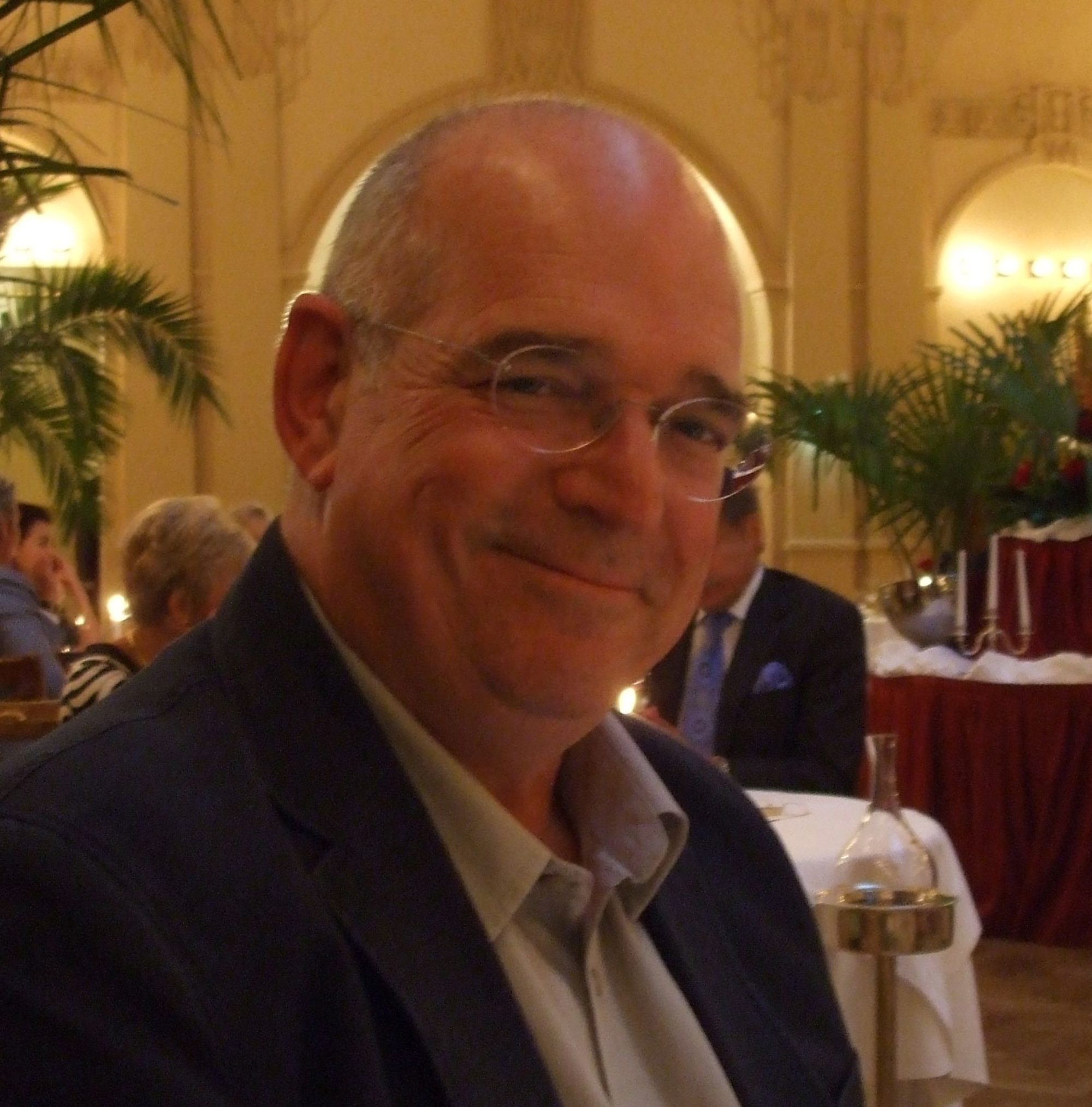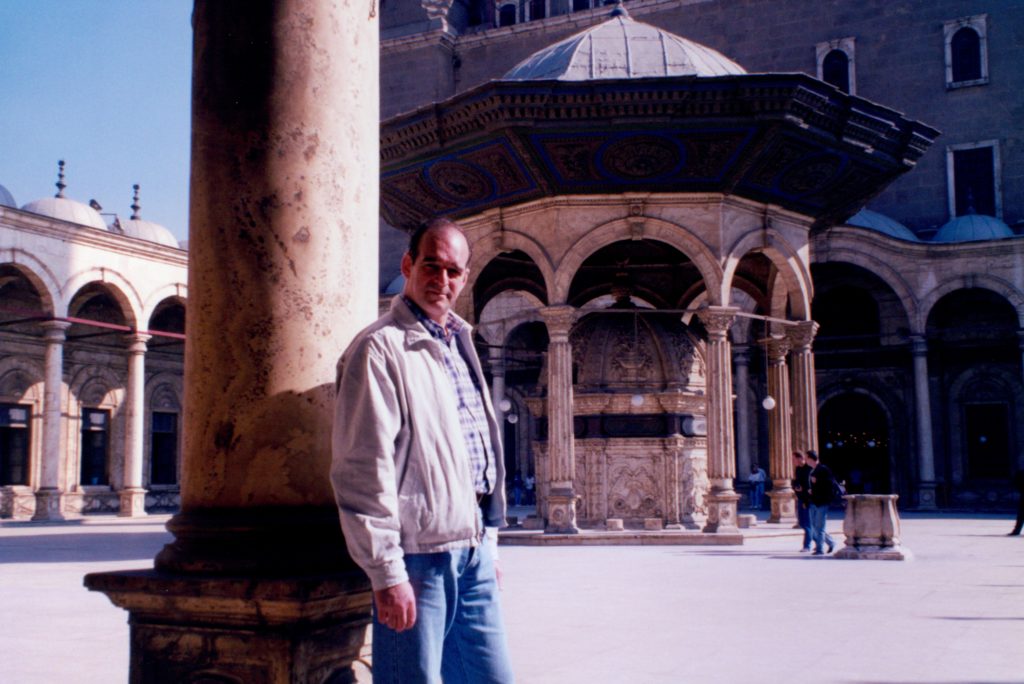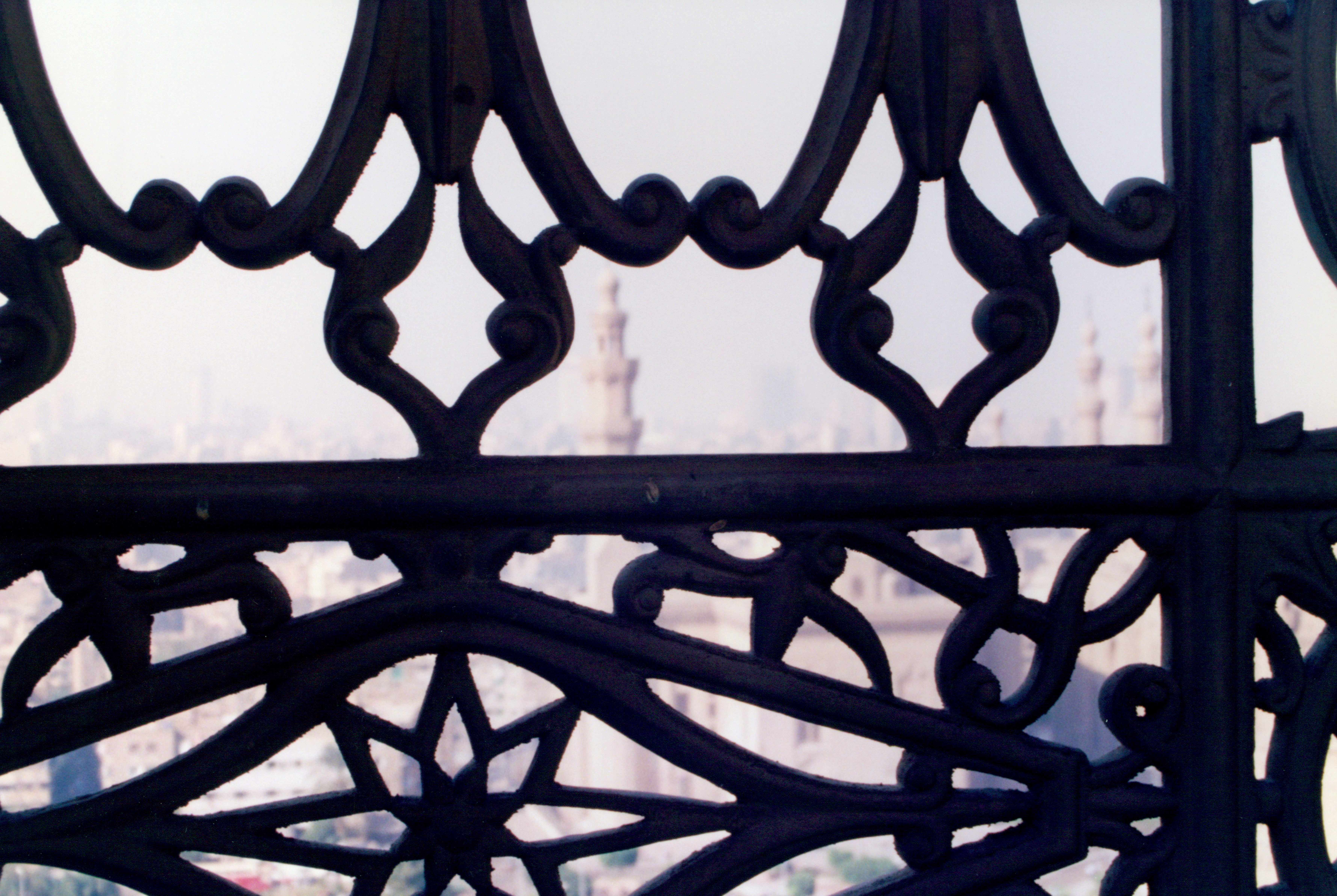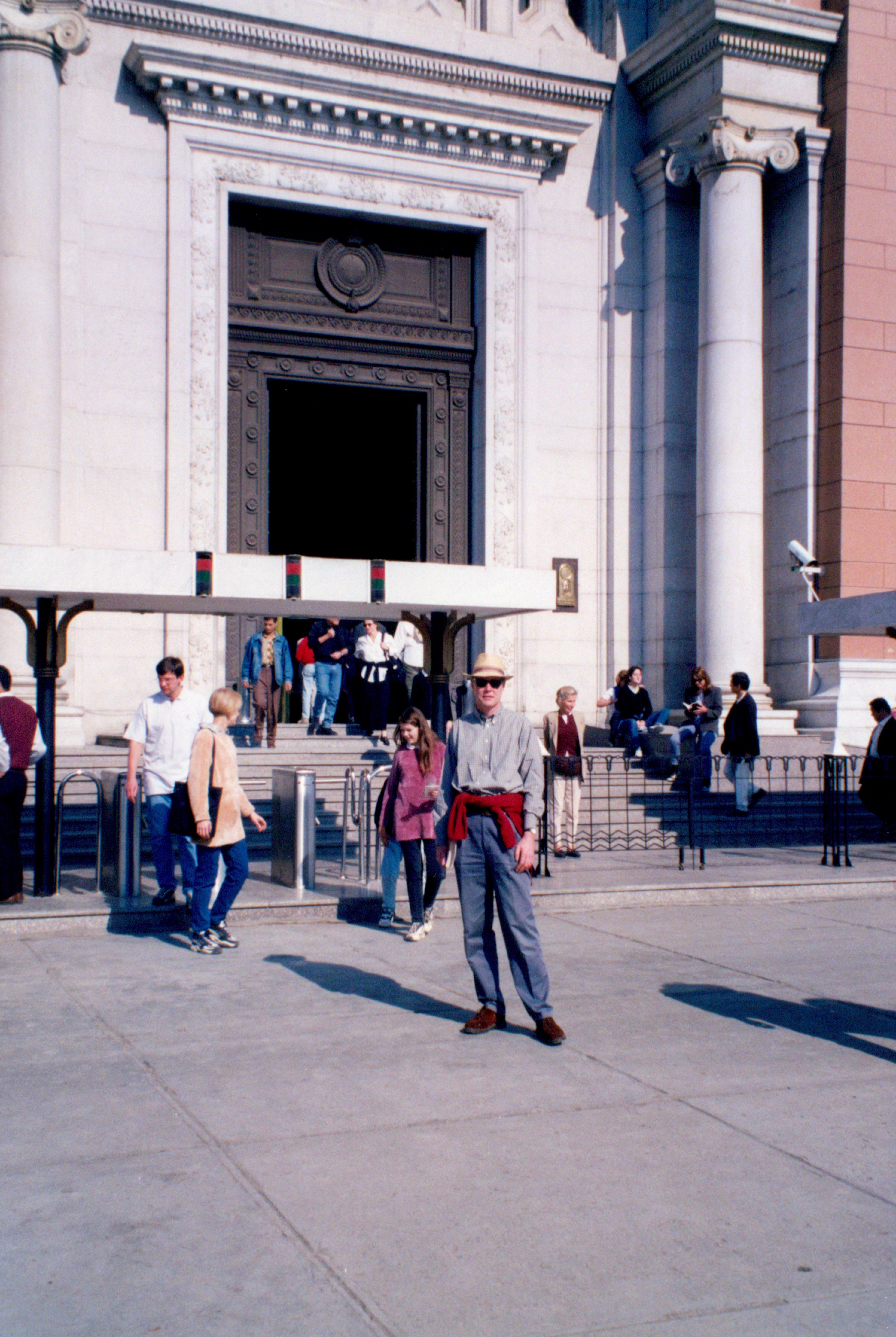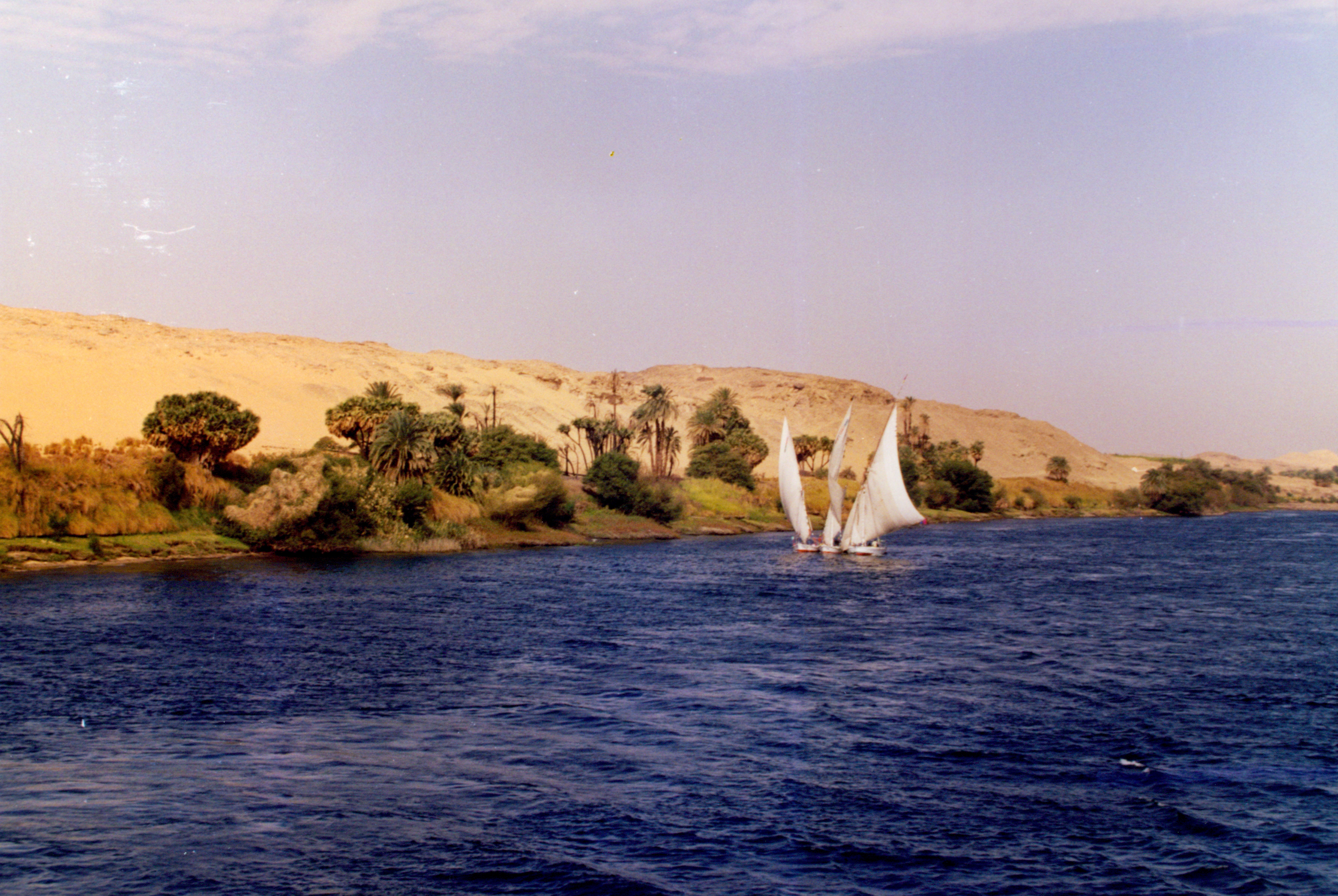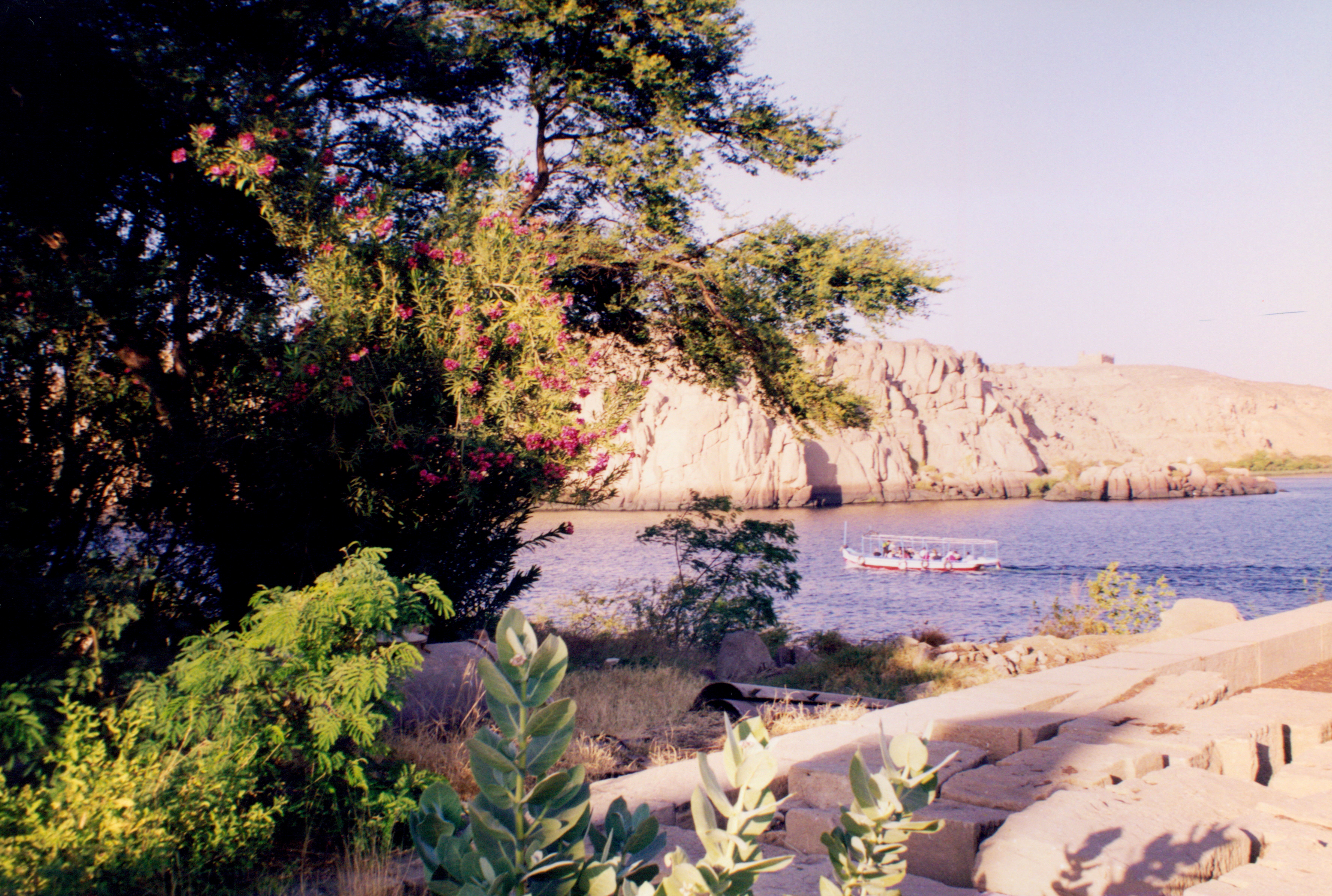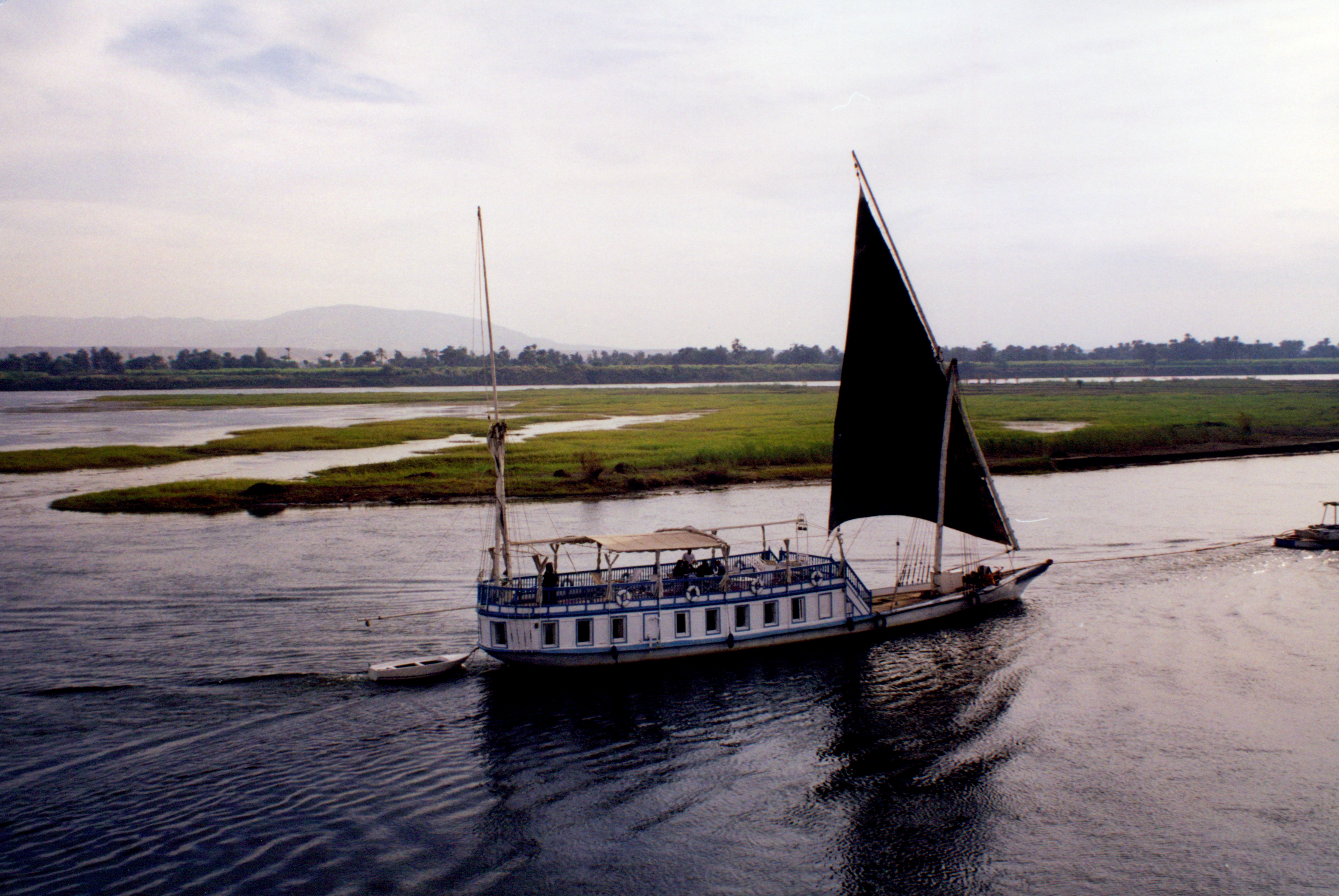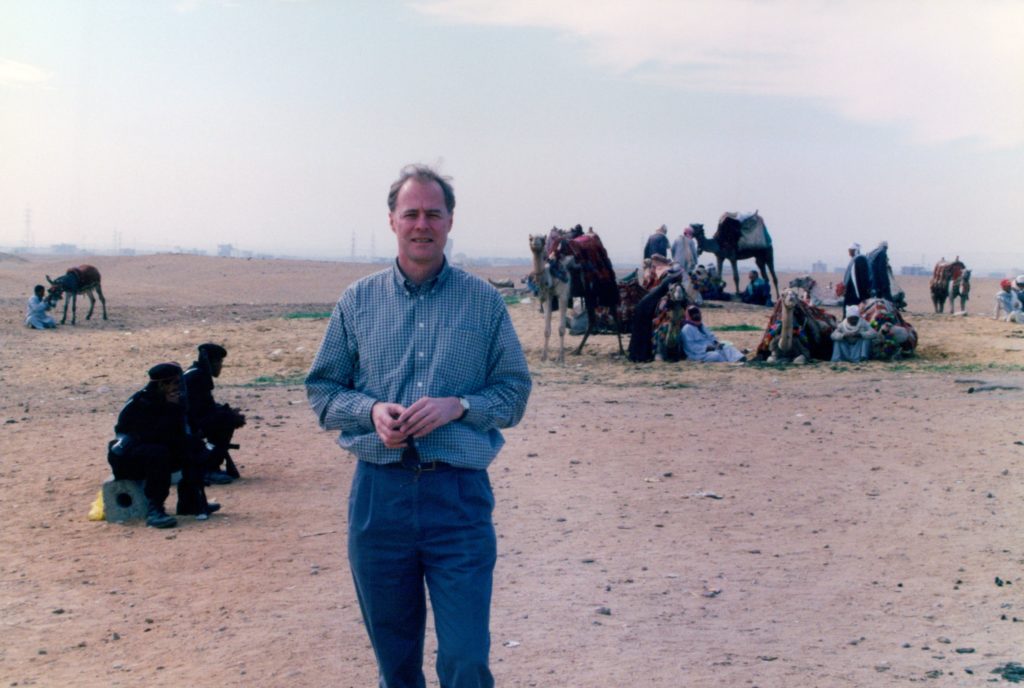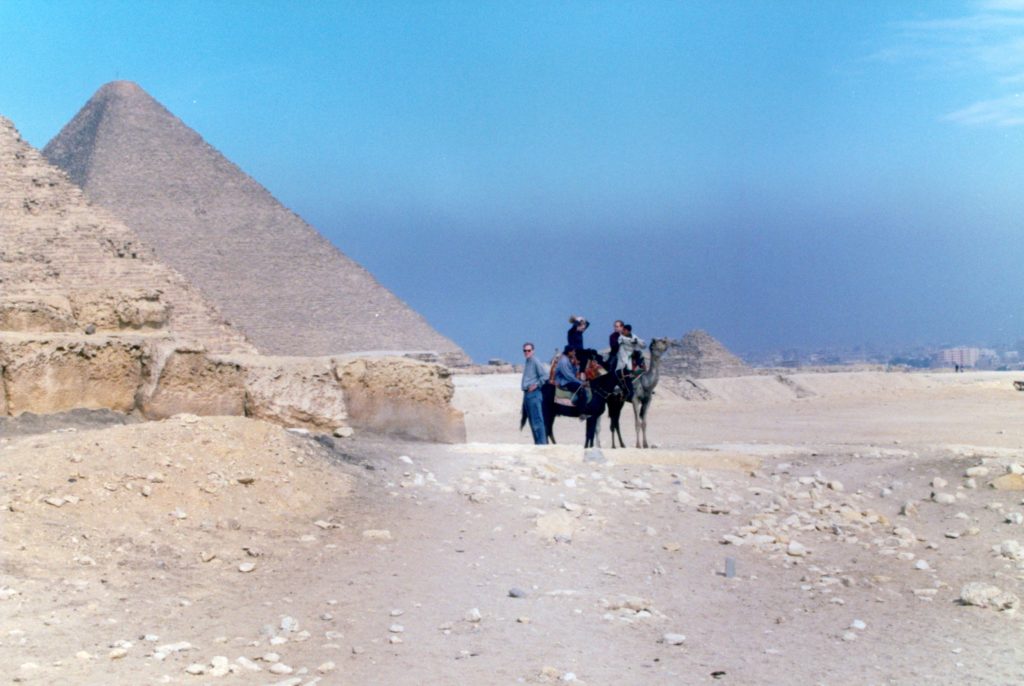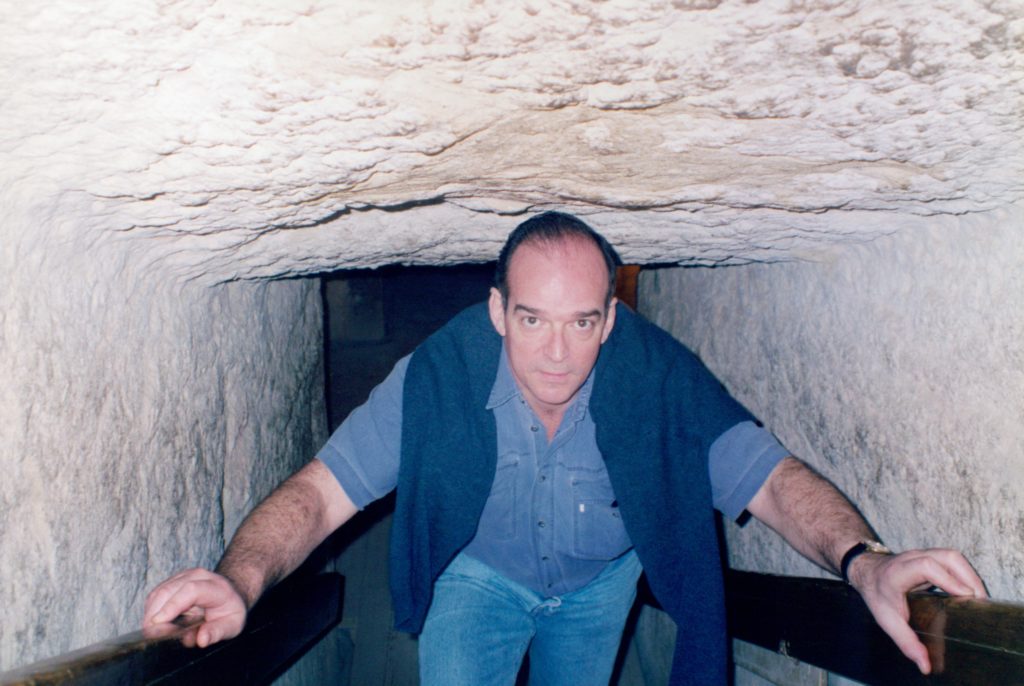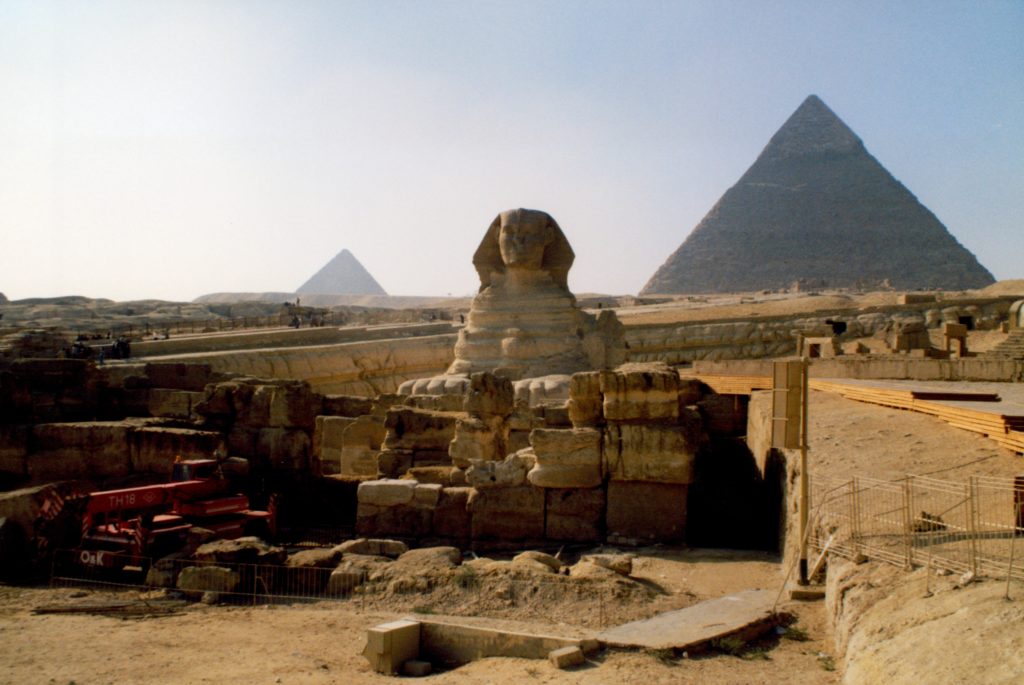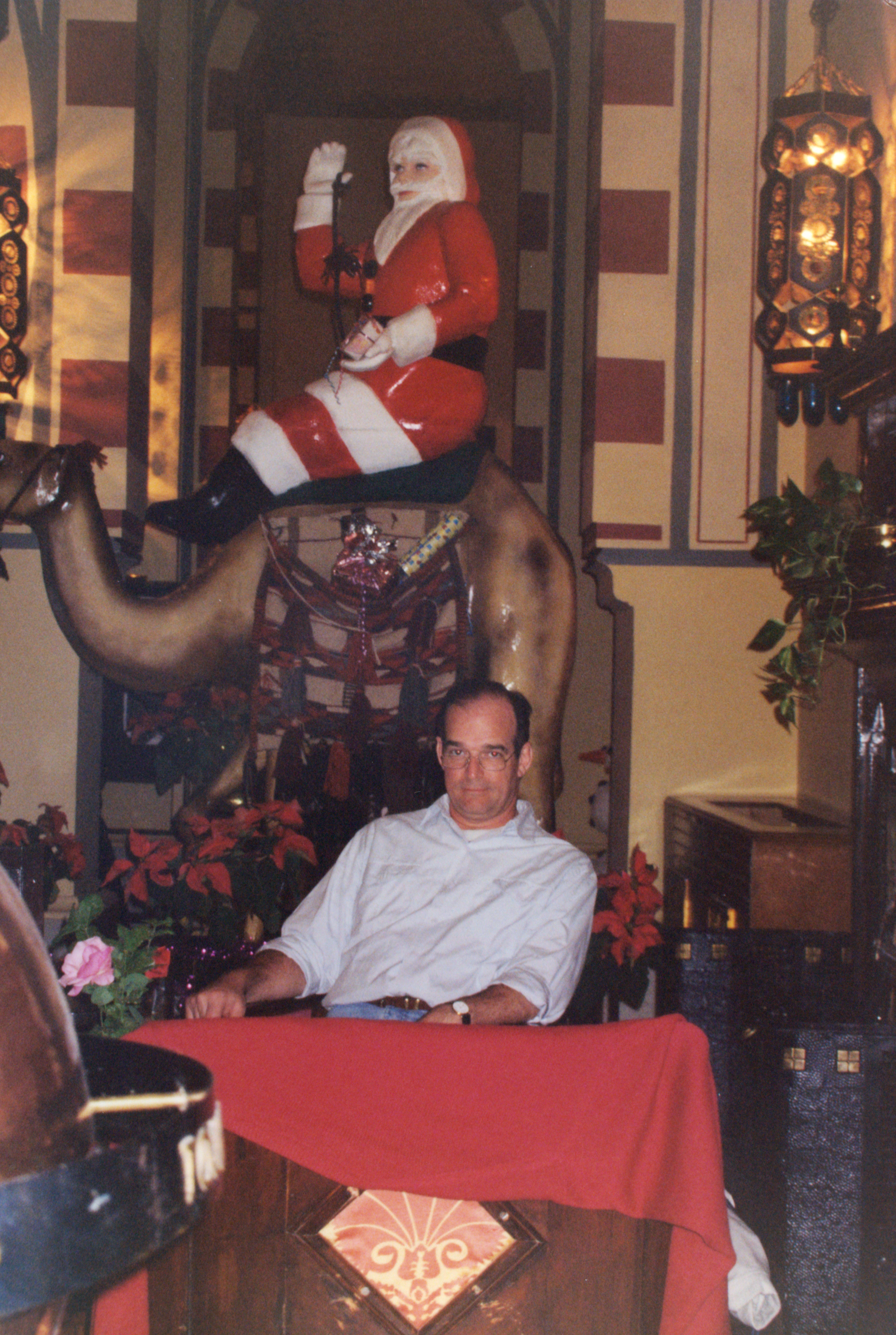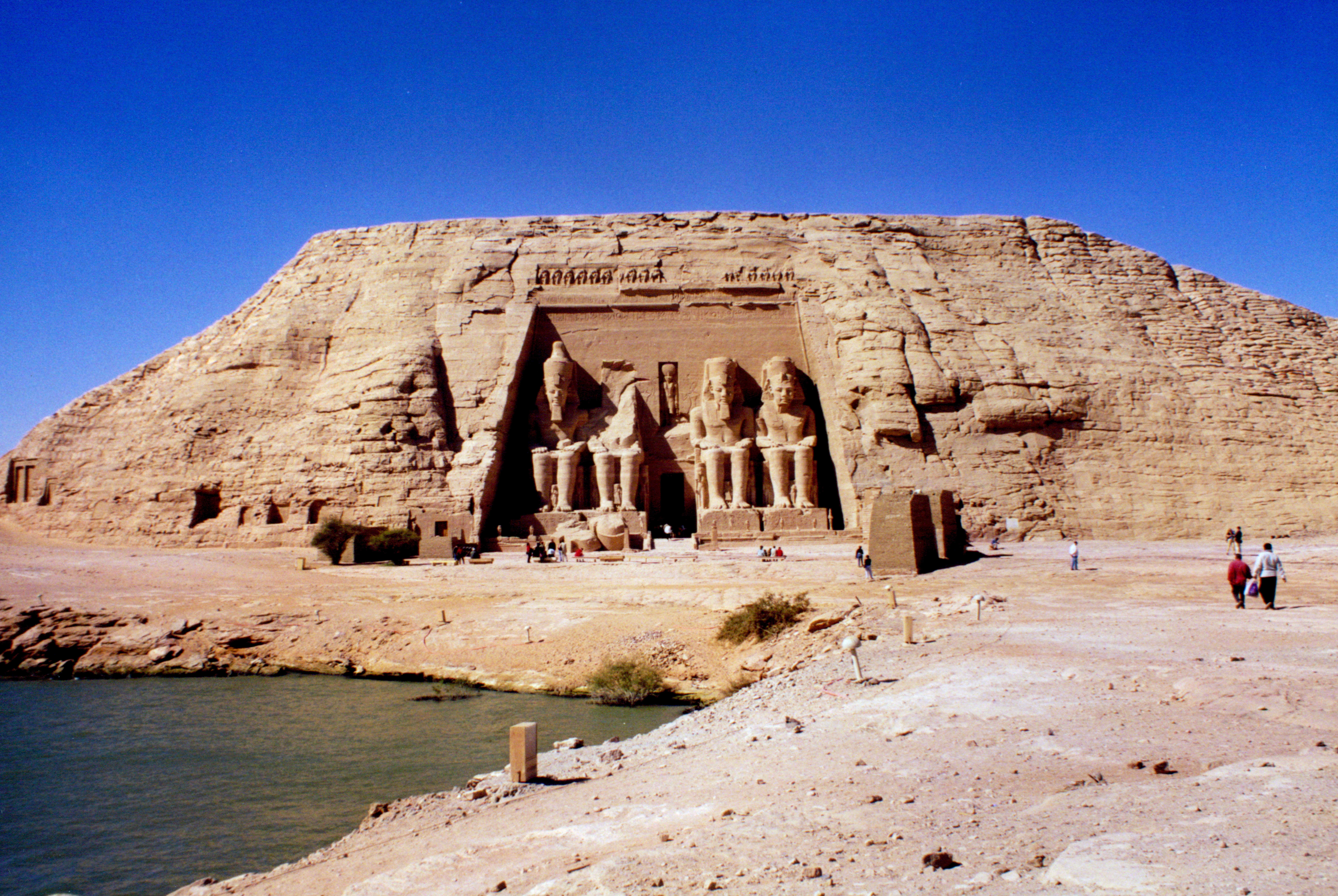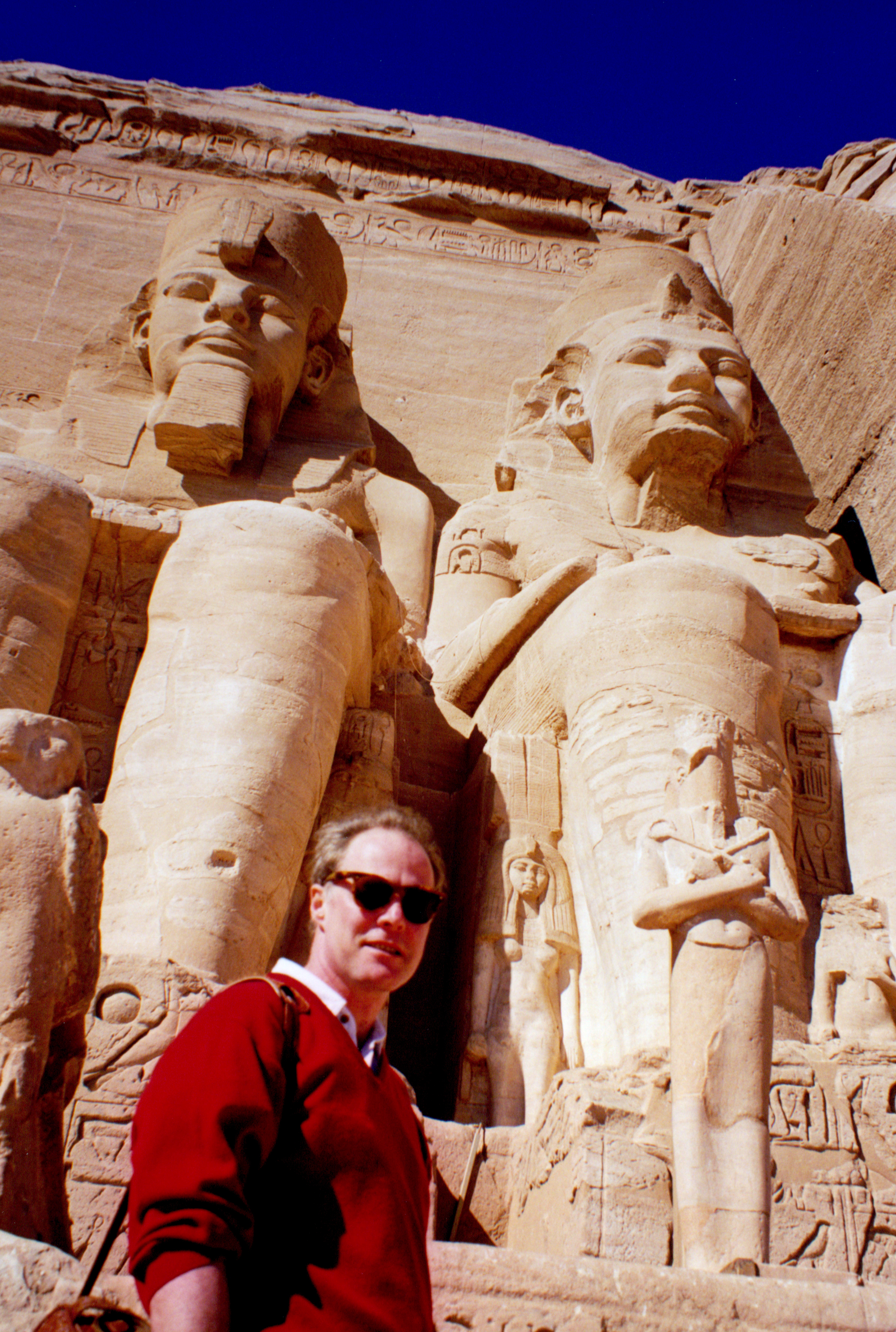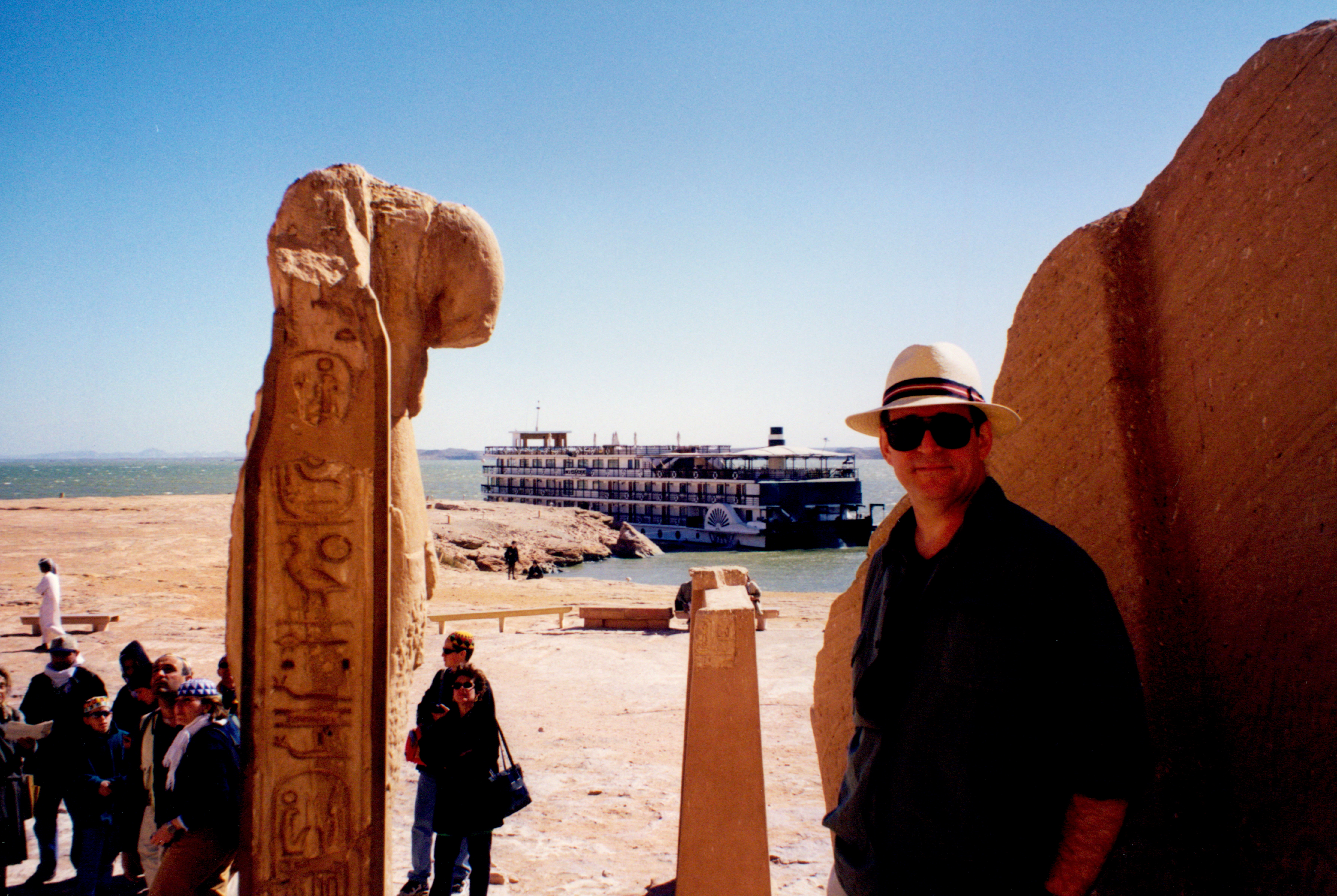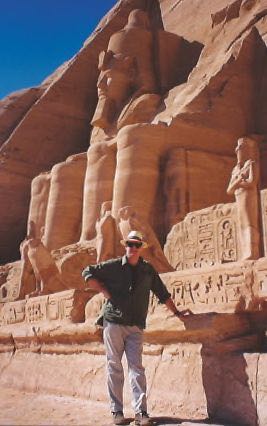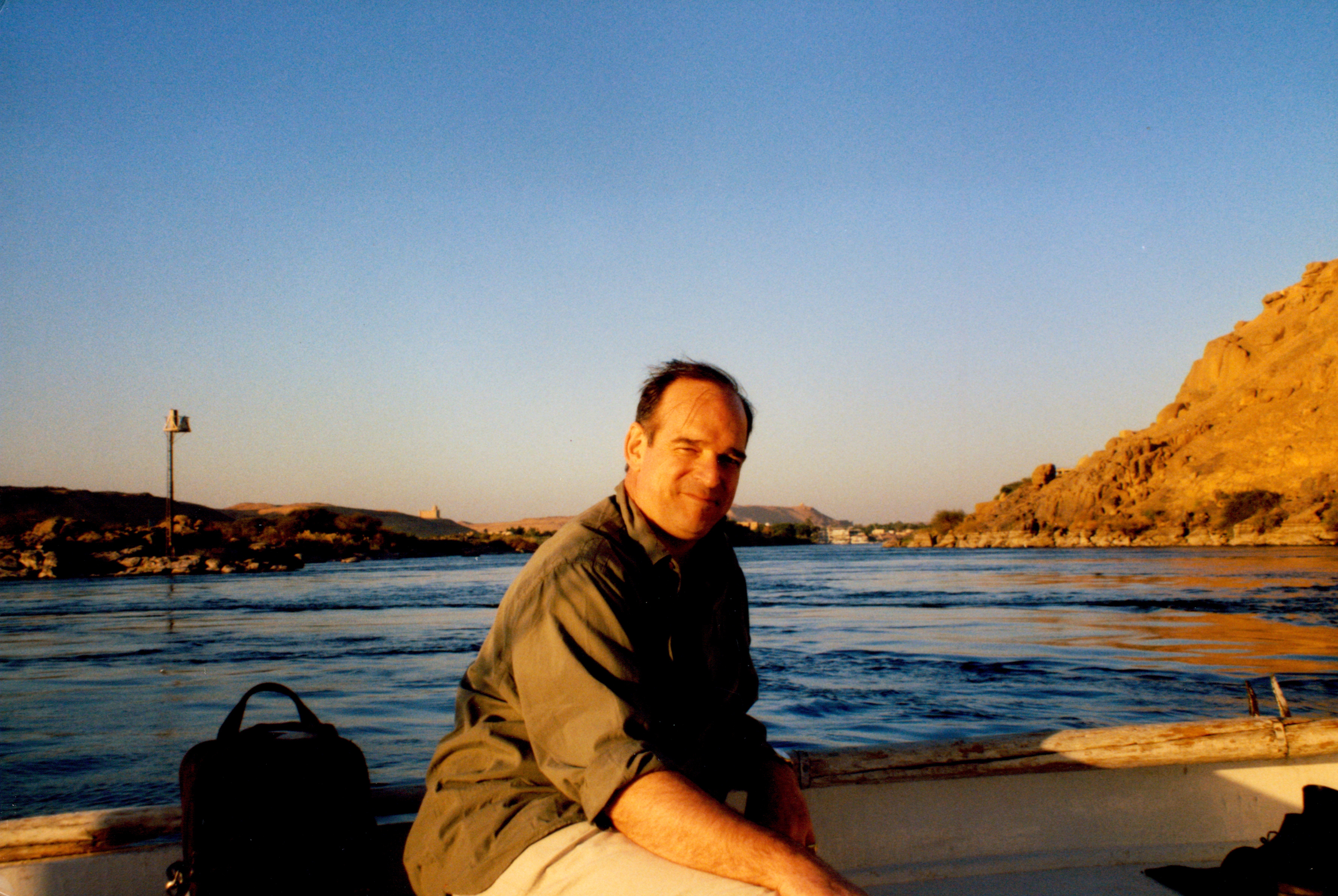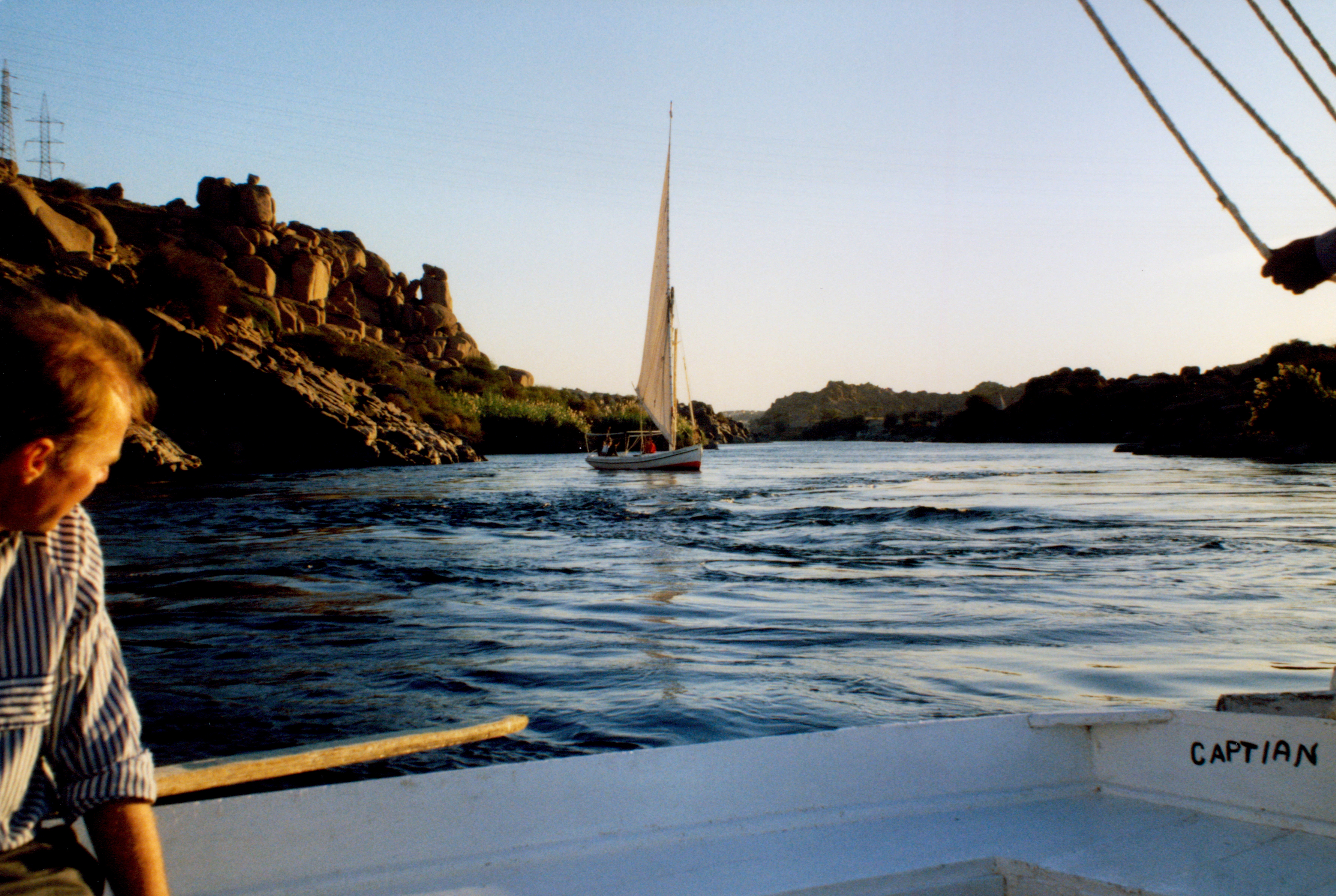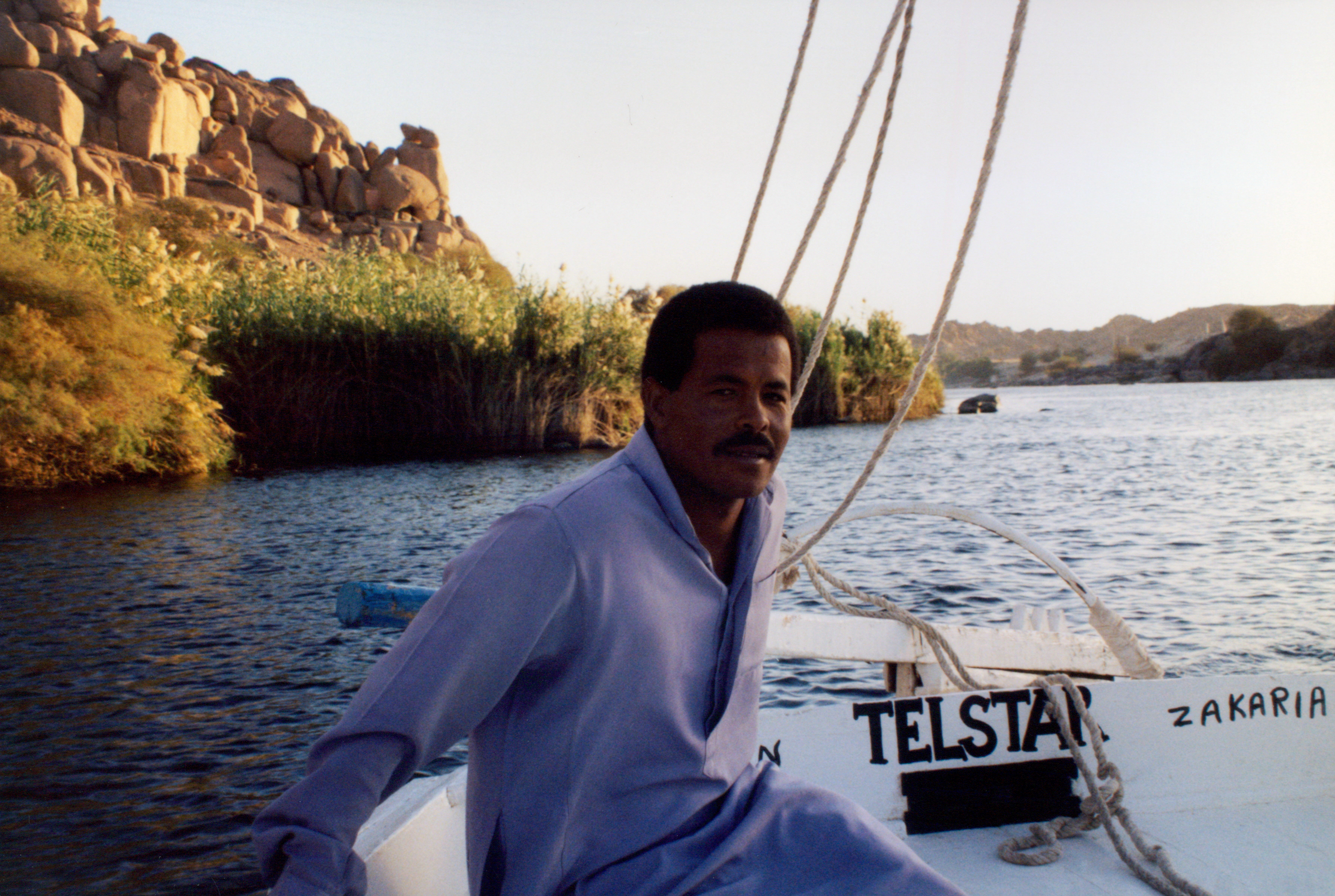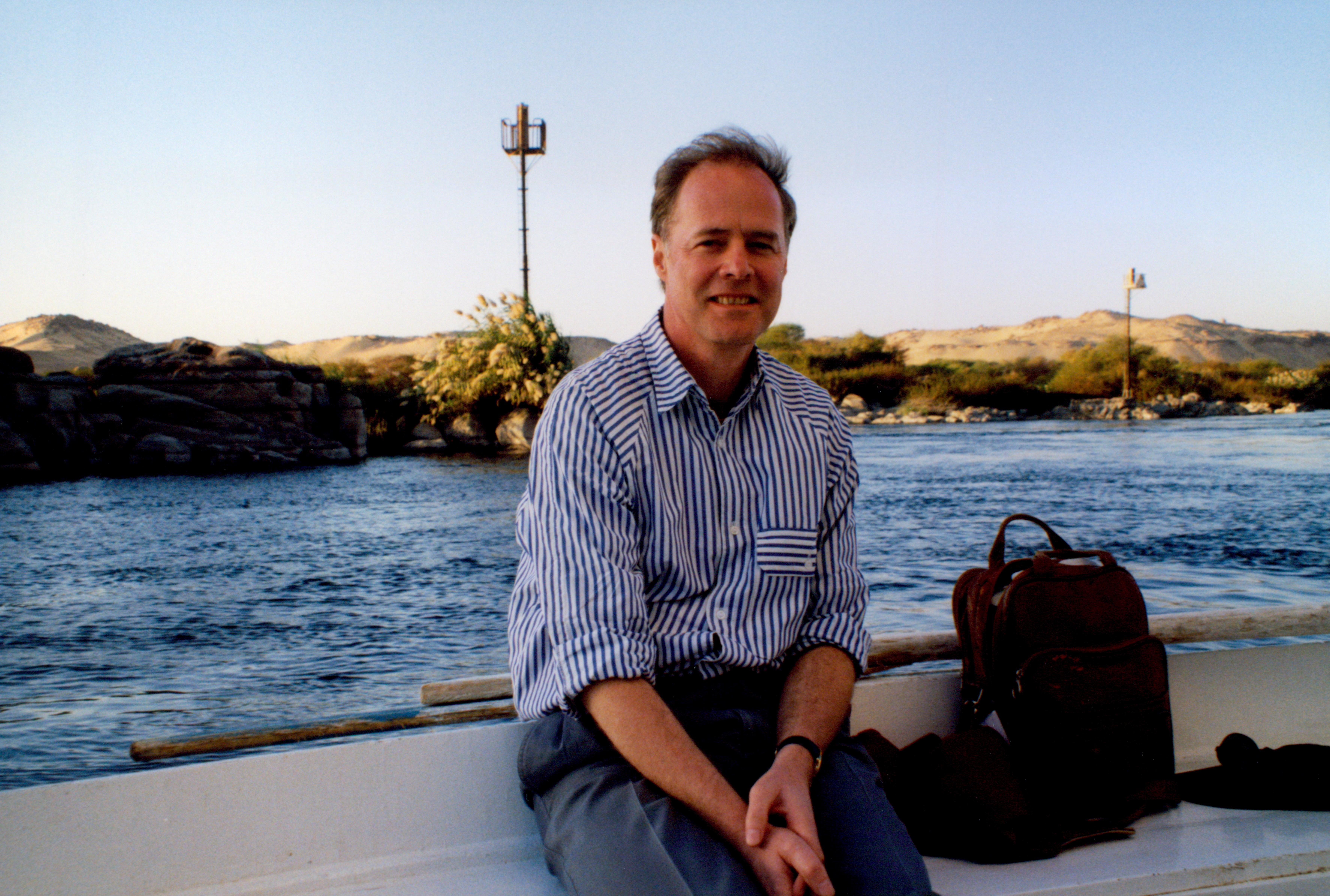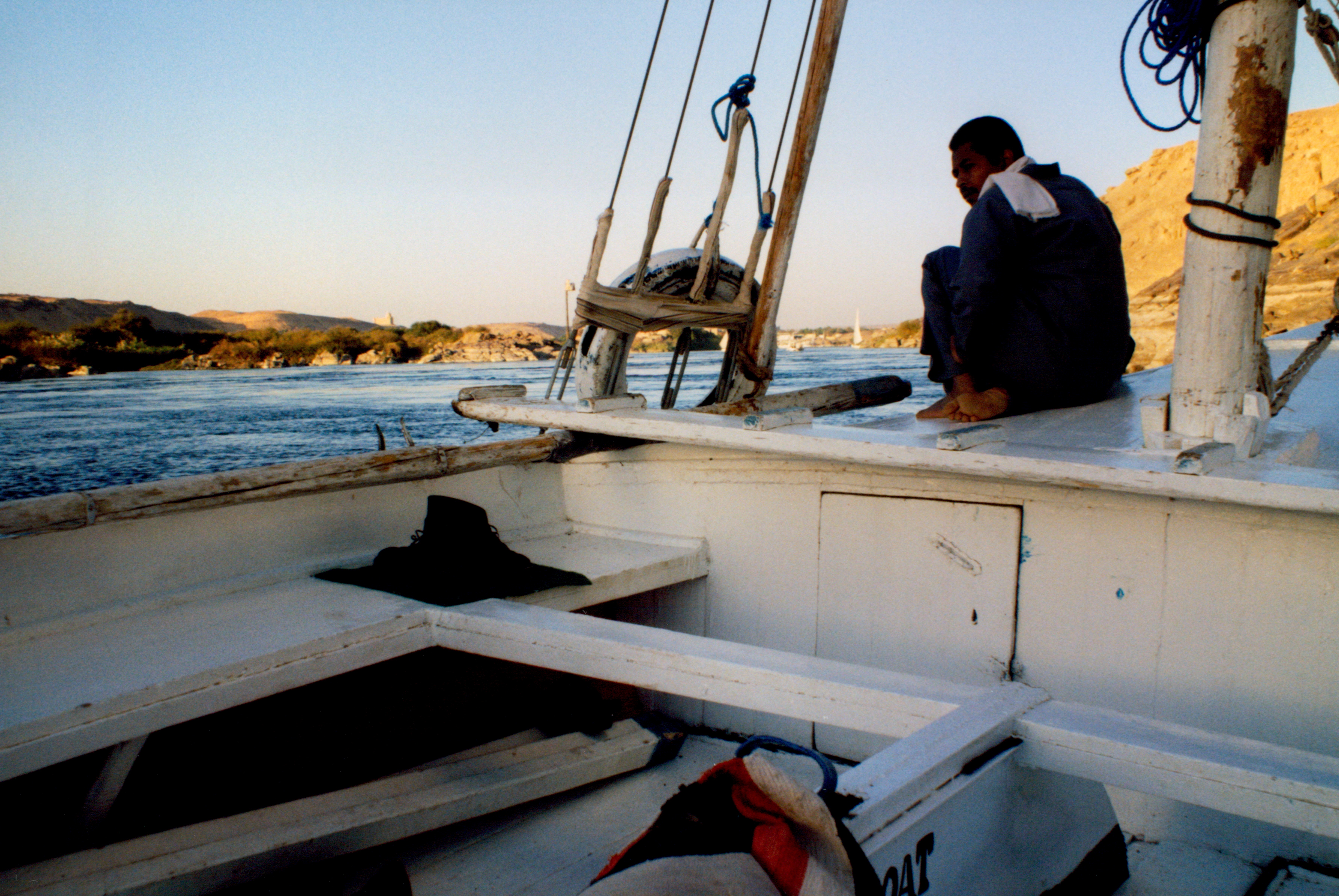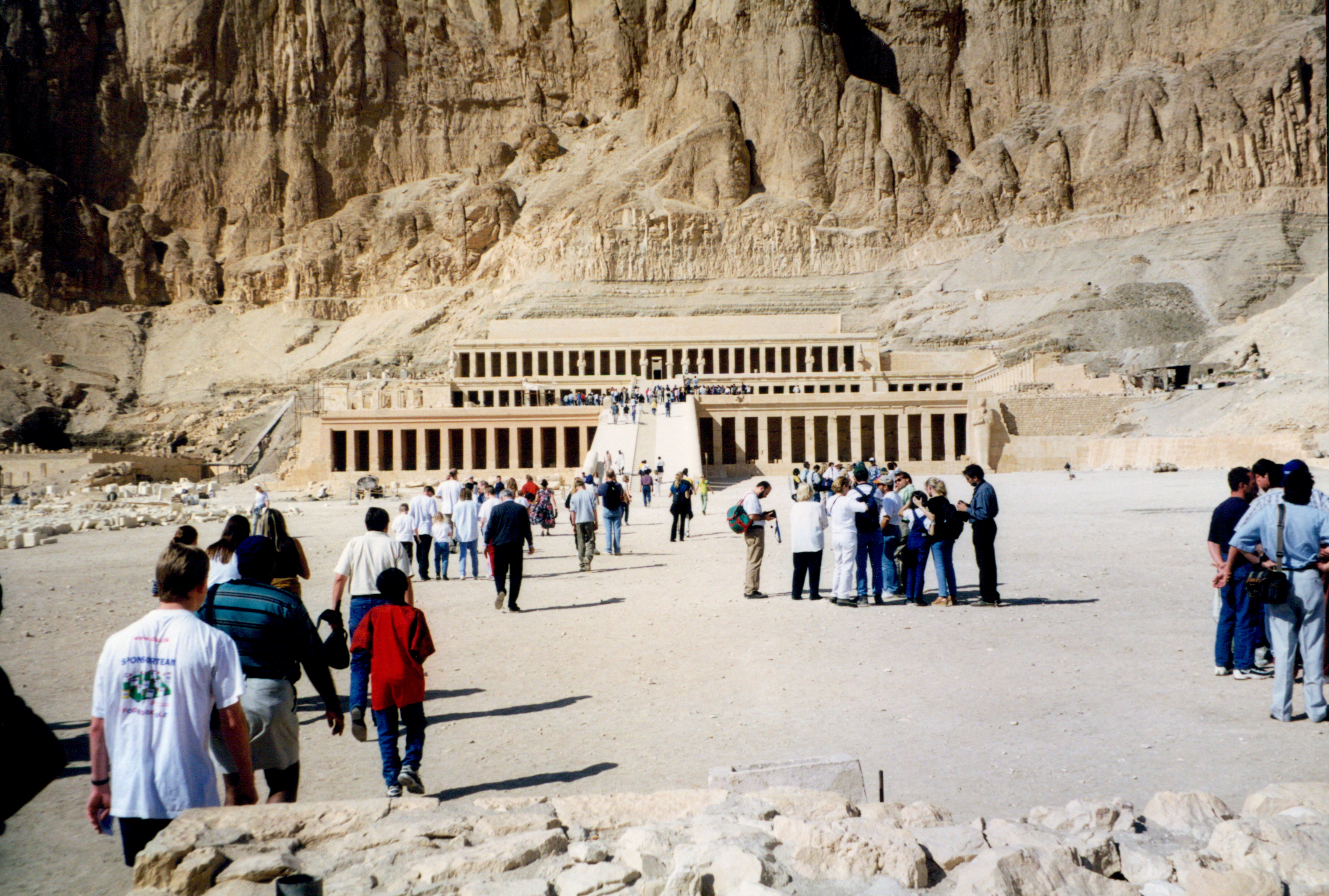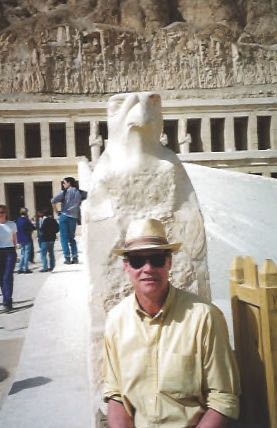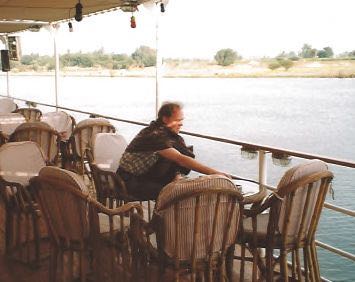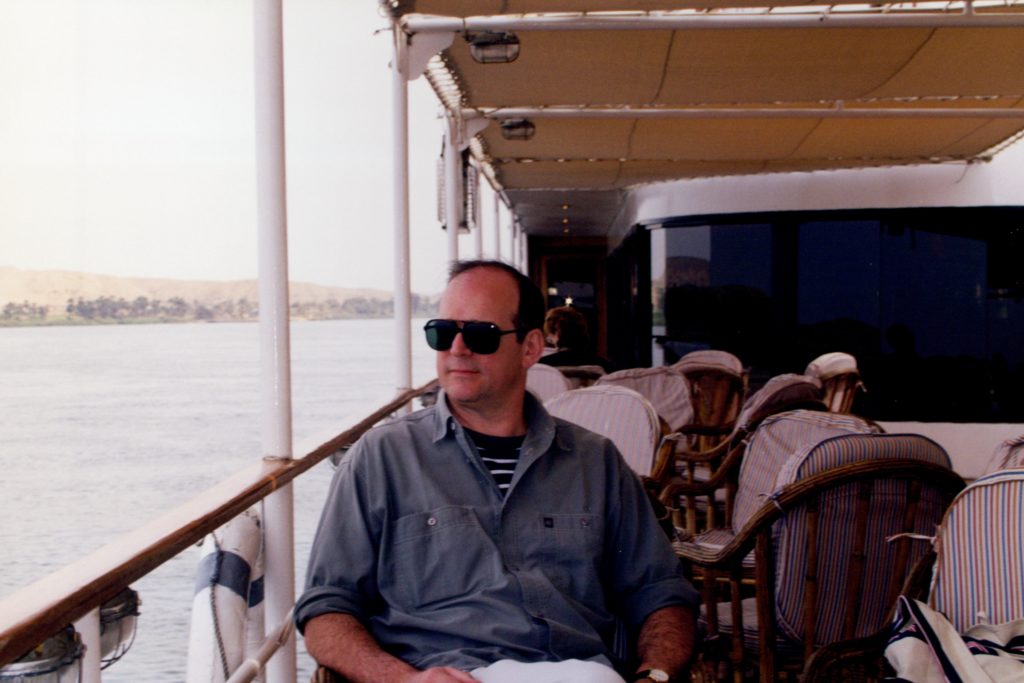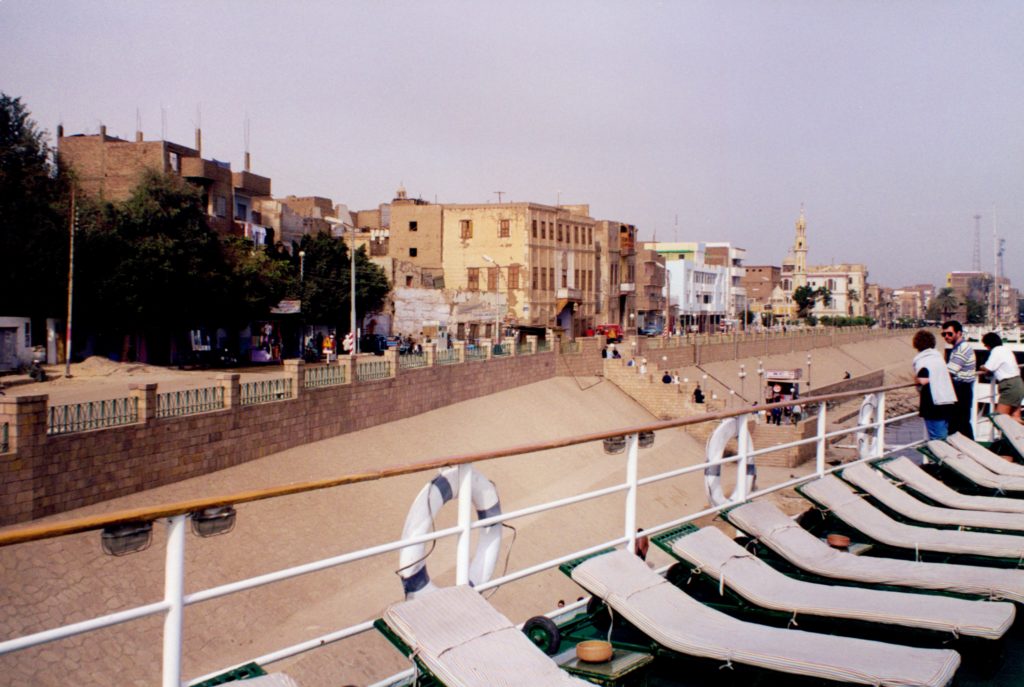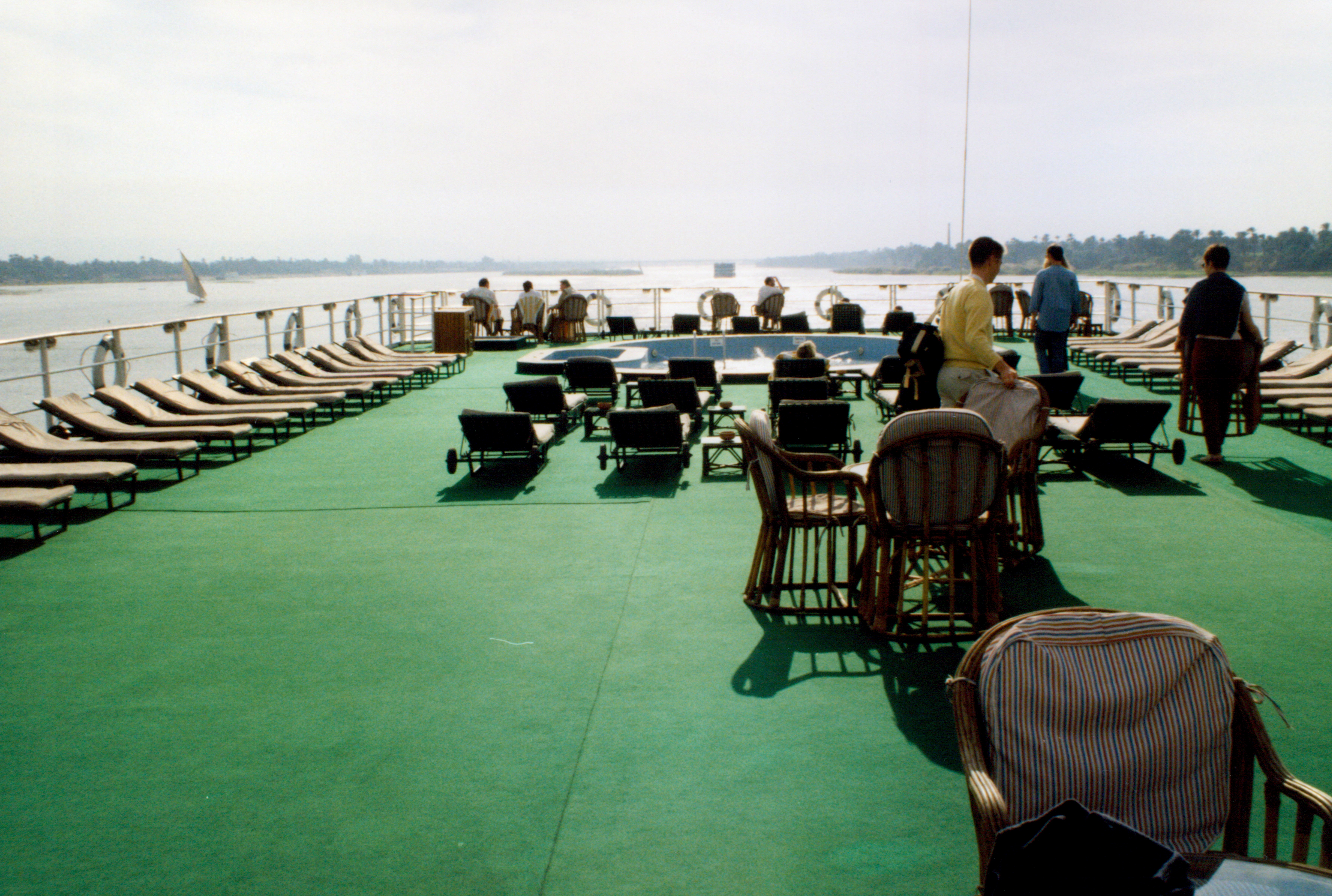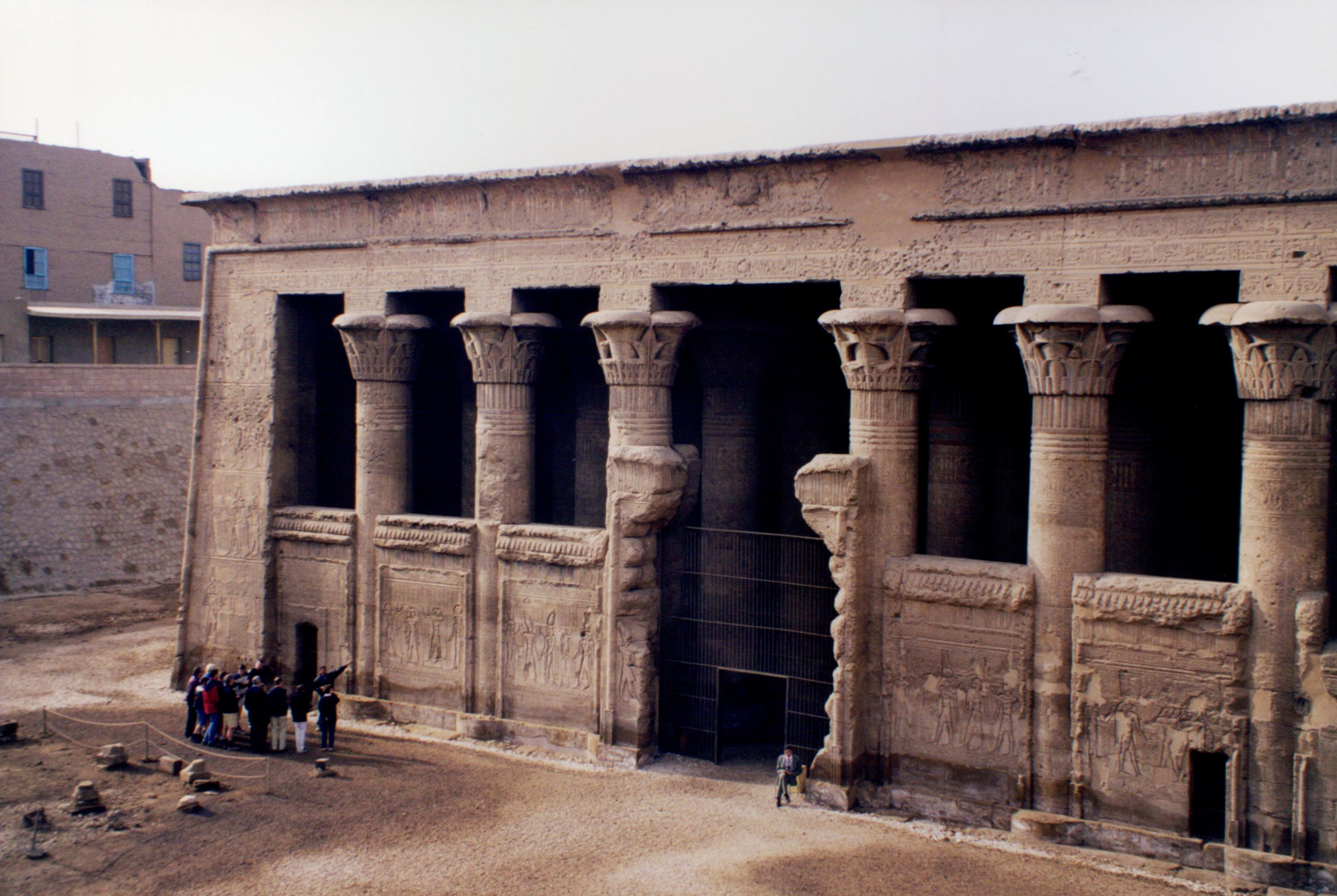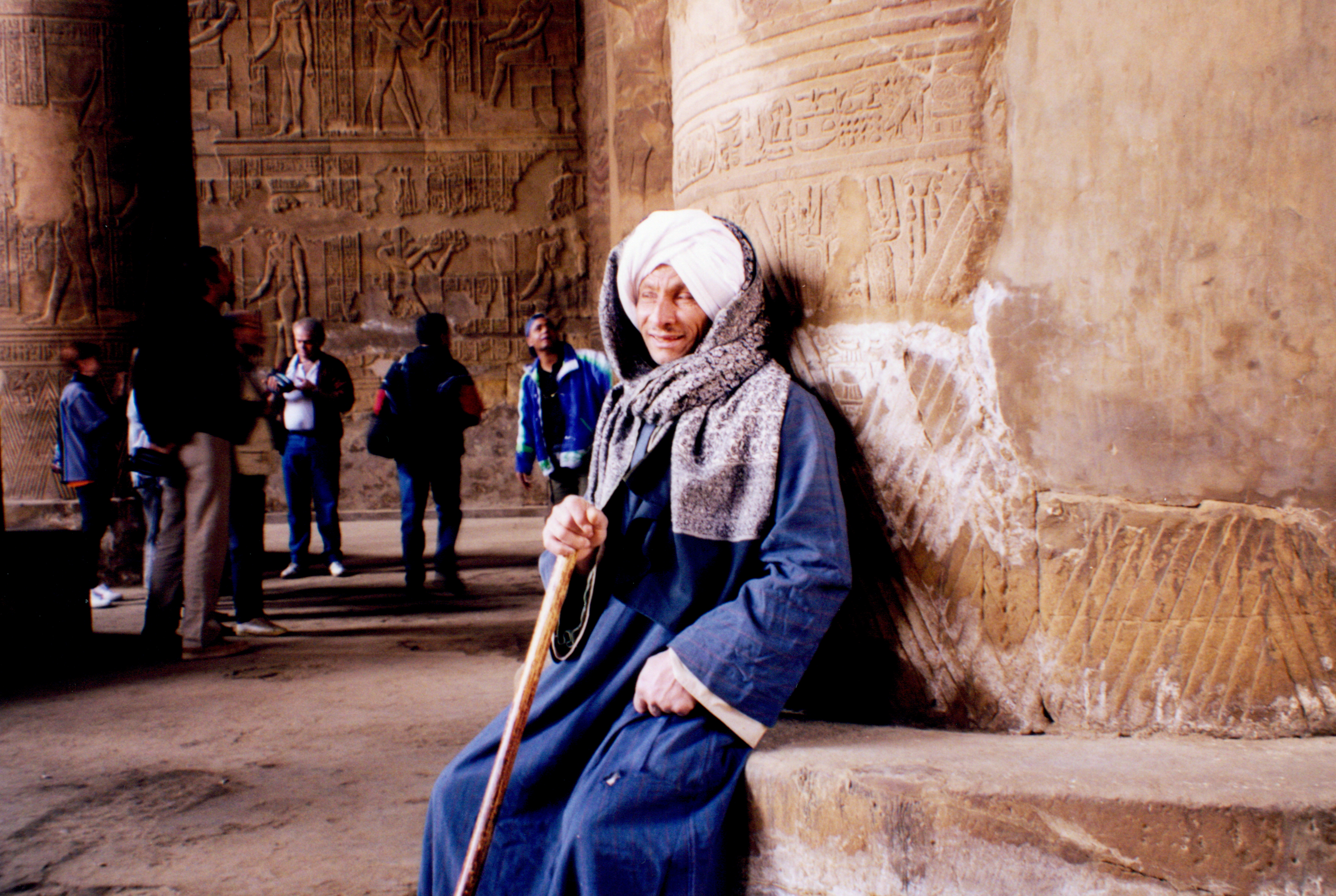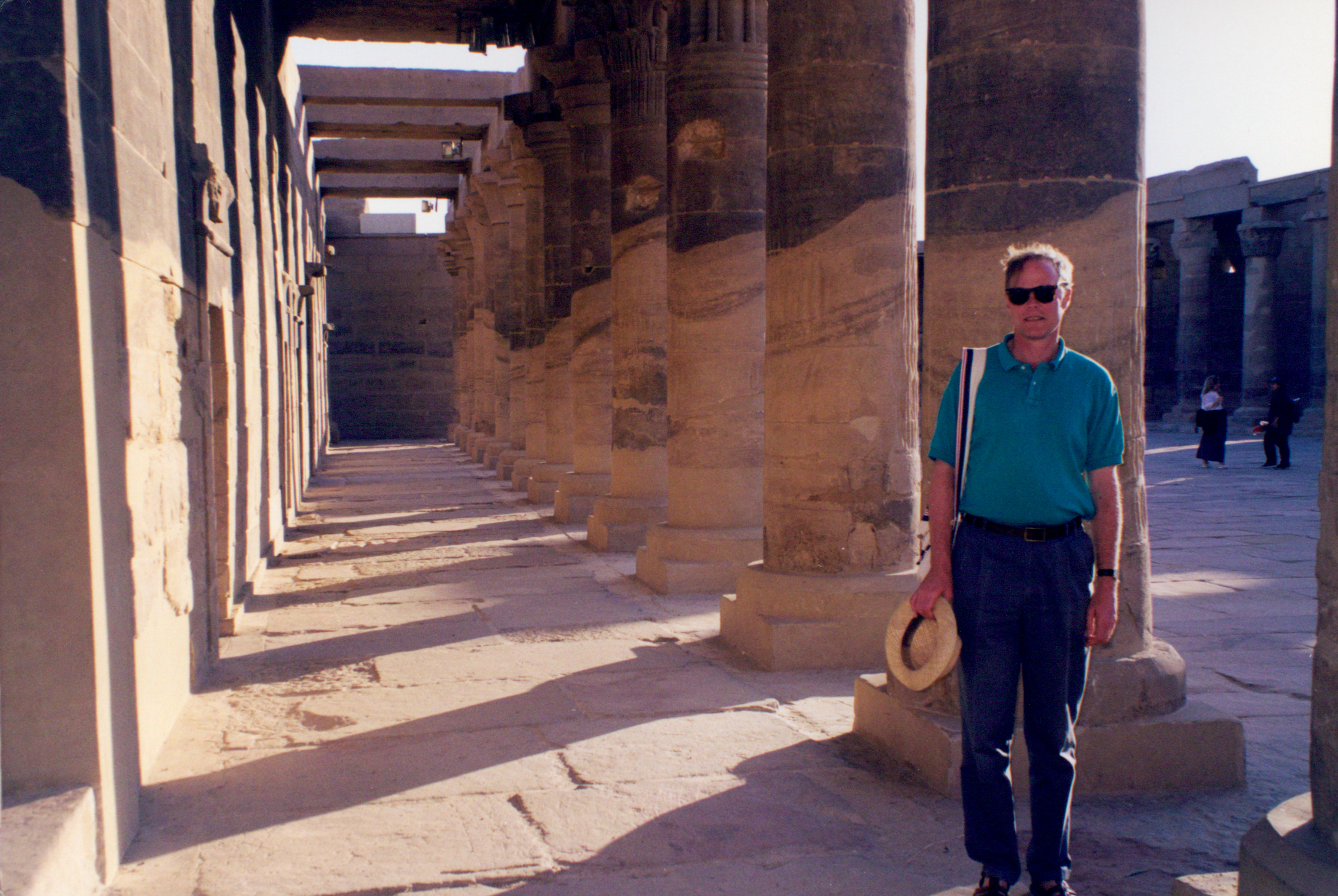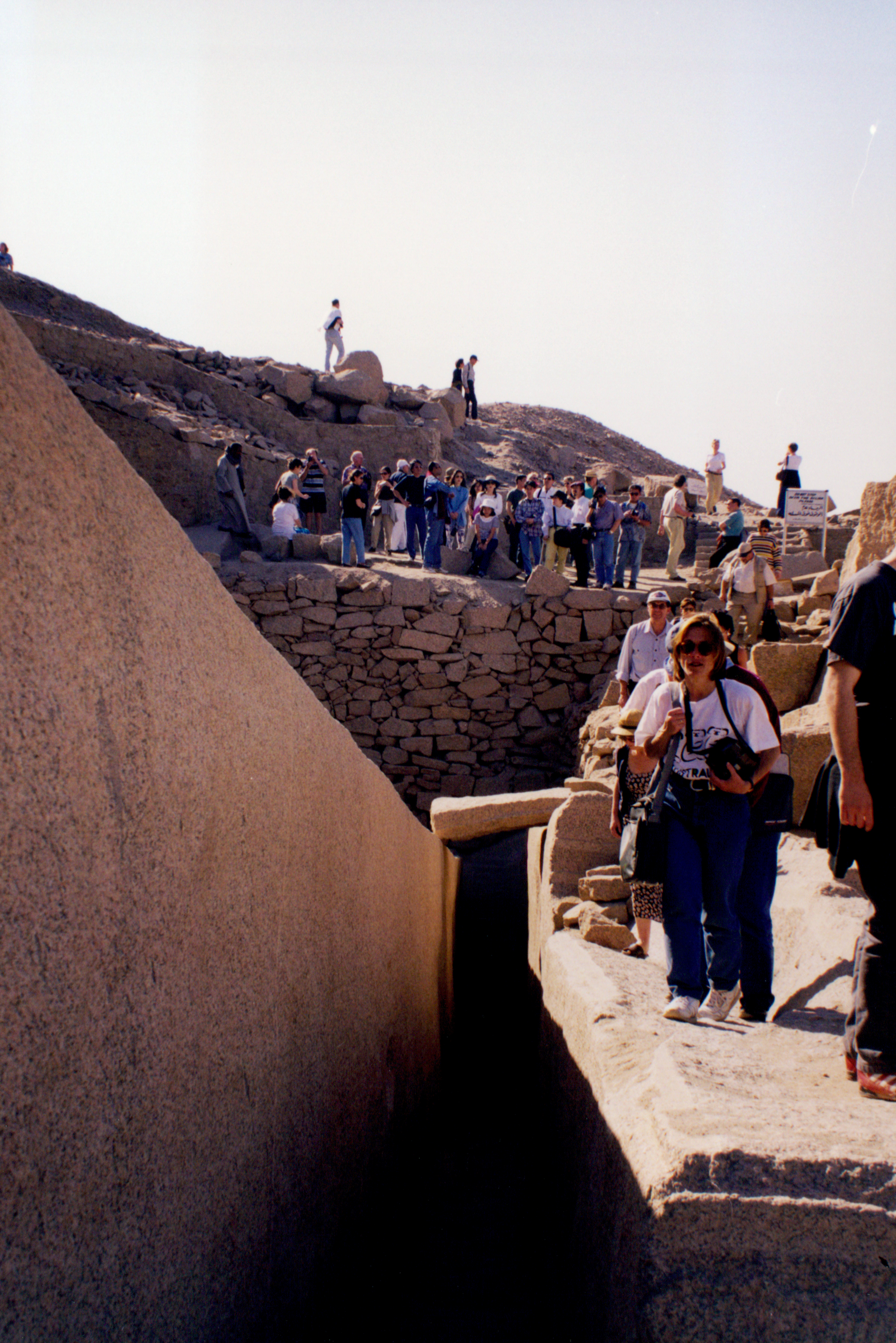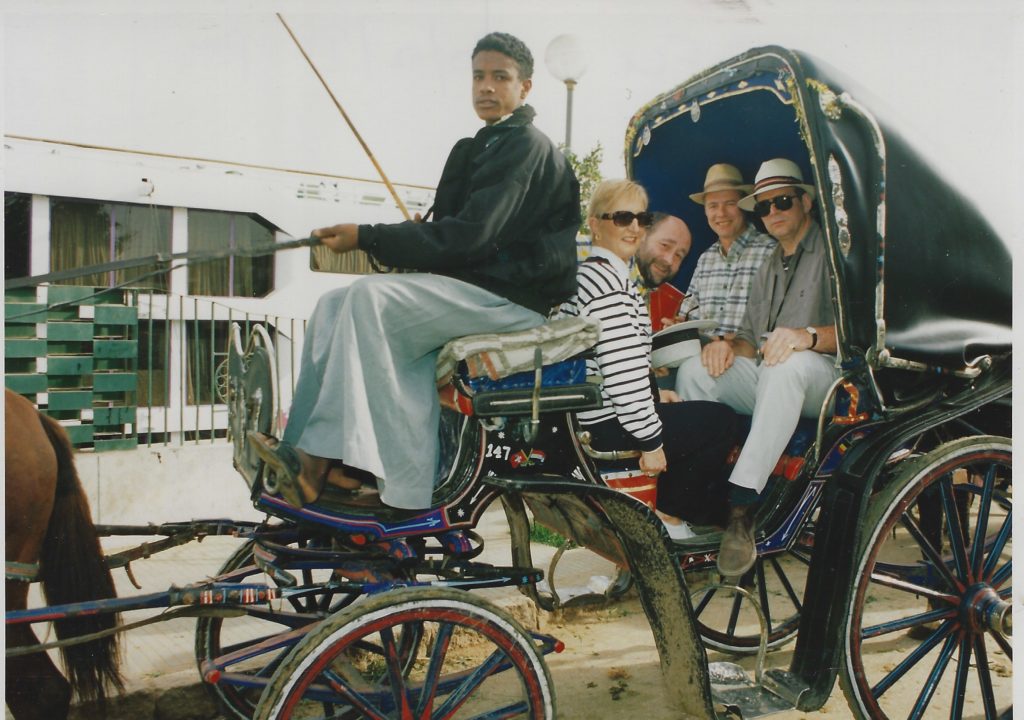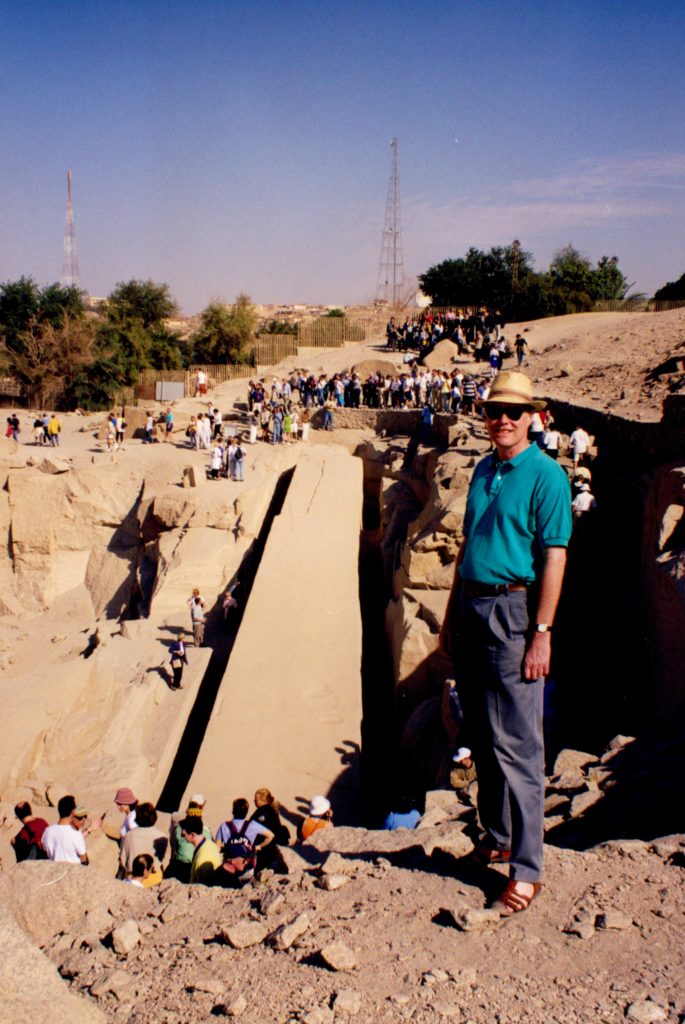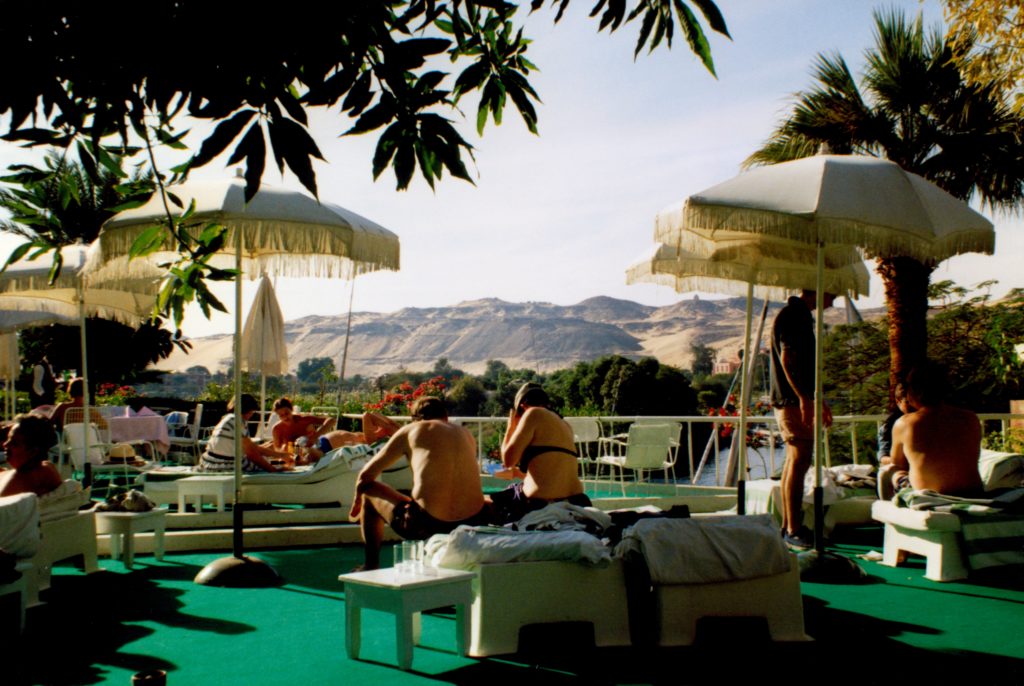A LETTER HOME
London
8th January 1999.
Dearest Mum and Dad,
Thank for your Christmas/New Year fax at the beginning of the week. I’m so glad you’ve had a peaceful, stress-free Christmas and not been tempted to overdo things.
It was lovely to be able to connect with you on Christmas Day from Aswan. I was conscious of the fact that we were all, at least, on the same continent – albeit several thousand miles apart.
The front door had to be forcibly opened when we returned late on Monday because of a six hour delay at Luxor……………..
13th January:
I have a ghastly gastric bug and am now laid up in bed. Yesterday a high temperature. I hope it passes quickly – in more ways than one, I can tell you!
Where to begin?
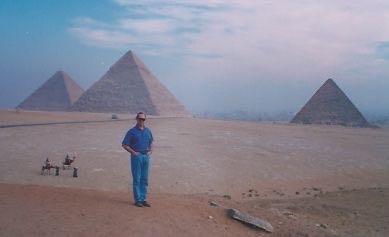
Giza
Egypt was fantastic. What an extraordinary experience.
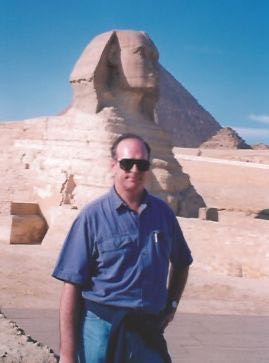
Tony of course had been there before but for me it was a revelation. The age, the splendour of the antiquities; the brilliance and imagination of a people so far off in time; the contrast between the pharoanic and the present day Islamic. The dirt, poverty, pollution and frustration of Cairo contrasted with its energy and brilliance. The maddening touts who would never leave you alone; the
wry and dry humour of the Egyptians and the gentleness of the Nubians – I was unprepared for the culture shock but don’t for an instant regret having gone and hope one day to return.
Our time was full and I said to Tony at the end that for all we were there only eighteen days, it seemed that at least a month had elapsed by the time we returned to London.
We flew to Cairo first and stayed in Giza, near the Sphinx and the great pyramids, Khufu [Cheops], Chephren and Mycerinus: you will be familiar with them of course as they are used in every brochure and travel film ever made. What I didn’t realise is that they are always photographed from east to west, making them seem isolated and mysterious but, in fact, they’re on the edge of the suburbs of Giza; and the Sphinx, an altogether smaller edifice than I’d imagined, is literally a hundred yards from the high street.
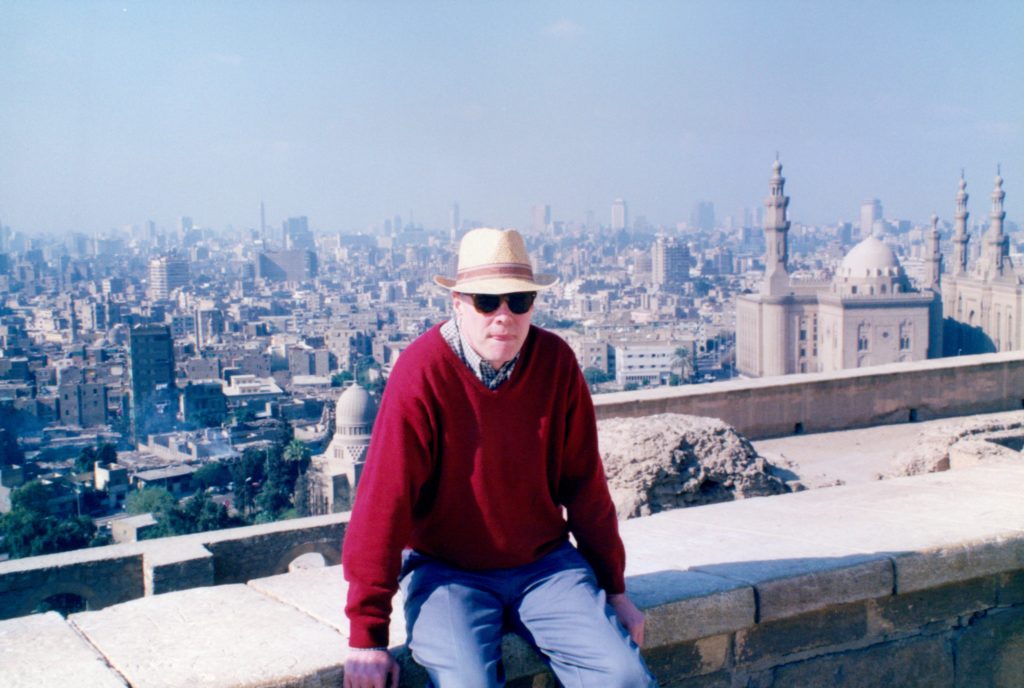
Our first visit was into central Cairo on the first morning. We hired a taxi for the day – the driver was the third cousin of the brother of the second wife of our Bell Captain at the hotel, I kid you not; easier to get a cab to take you around – very cheap: about a tenner for the day. The main reason for being in Cairo was the Museum of Antiquities where the great Tutankhamun Funerary collection is housed.
By getting there early, Tony and I were the only people in the rooms on the first floor: a spectacular collection of funeral masks, jewelry, chariots, shabti figures and countless other quite astonishing objet d’art – all in immaculate condition and displaying an extraordinary perfection that make them seem almost modern. As you know, because he was a boy king, his tomb on the west bank at Luxor in the Valley of the Kings, was a small one; he was buried under the tomb of the far more important Ramses VI. In consequence, the grave robbers over the centuries never found it. When Howard Carter opened it in1922 it was intact. Remarkable that such a small, unimportant tomb as Tutankhamun’s could yield such vast, beautiful treasures. One wonders what must have been contained in the other, more important tombs. We wanted to see them all in the Cairo museum so as to be able to place them in context when we finally got to The Valley of the Kings at Luxor.
We spent time in Islamic Cairo too, at The Citadel. Interesting. Such a huge city; some say as many as 22 million though its official population is about 16 million. It must be the third or, even second largest city in the world – and a “third world” one at that. The contrasting poverty and wealth are evident.
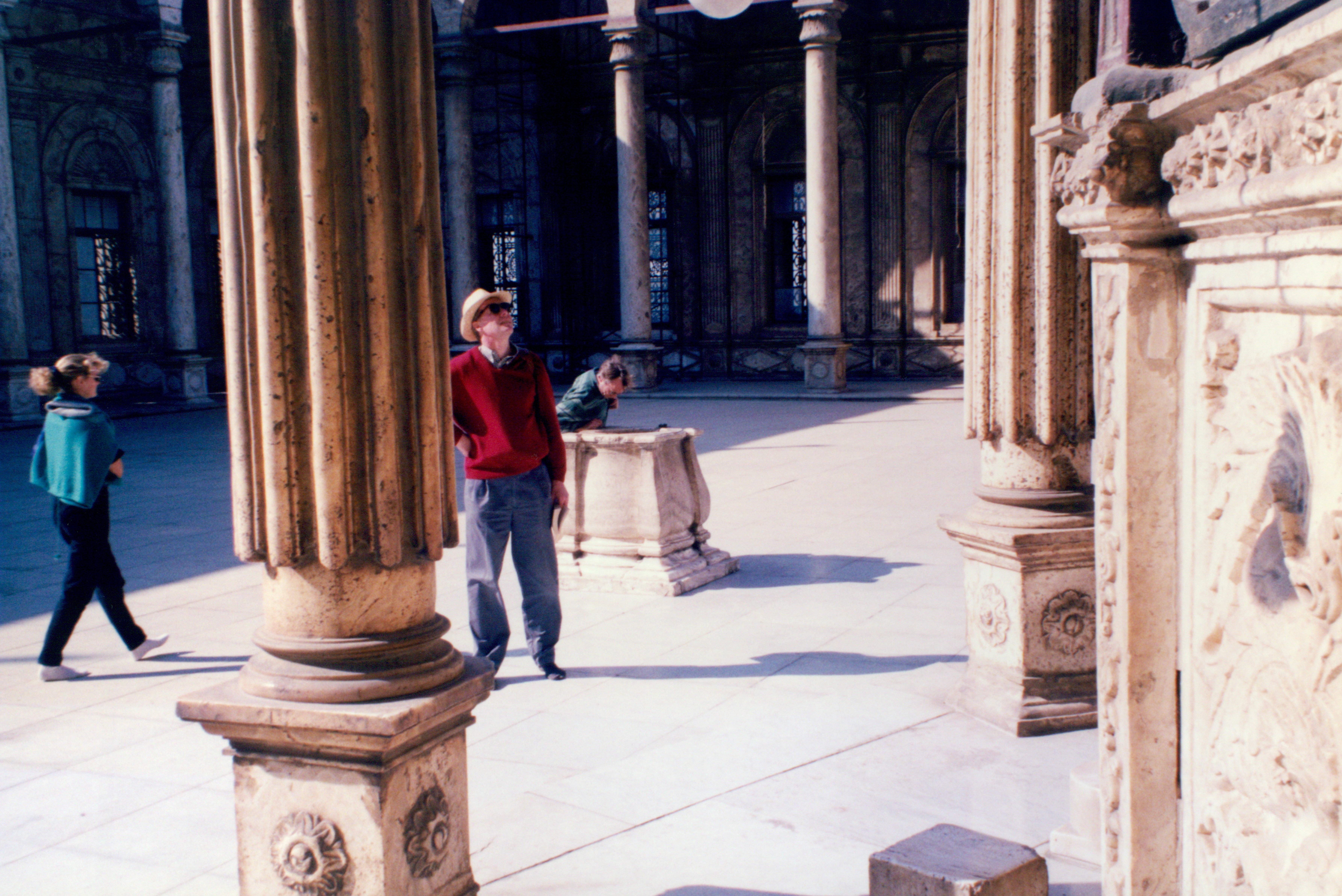
I’ve never seen such appalling traffic and pollution. If I described to you how our taxi driver got us into central Cairo on our first morning, you wouldn’t believe me. There are no traffic lights, hardly any traffic police and the morass of ancient vehicles, belching buses, the heat, the hooting, moves along in a gradual surge; you can’t believe you will ever be disentangled and reach your destination.
We didn’t begin to touch all there is to see: Coptic Cairo; the old Arab Quarter; Heliopolis and so on – there is so much. Of beauty and squalor. I suppose it says something for the Islamic way that the crime rate is low. We never once felt threatened or unwelcome and that begs the question why is there not a murder and robbery rate to equal yours [South Africa’s] or, even, ours? It must have something to do with the Islamic Code I guess? Anyway……
On our second day our taxi driver, ubiquitously, Ahmed, took us out to Saqquara to see the great Funerary Complex of King Zoser (BC2700 – nearly 5000 years old) and the first pyramid ever built on which were modeled the later and bigger pyramids of Giza and others at Memphis, Dahshur, Abu Sir, Abu Rash and so on. Again a useful contextual yardstick and a good introduction to the whole language of pharoanic architecture and religion. The surviving mastaba’s at Saqquara are incredible. That they are so old yet their hieroglyphs so clear; even, in some instances, to the colours used. We were speechless.
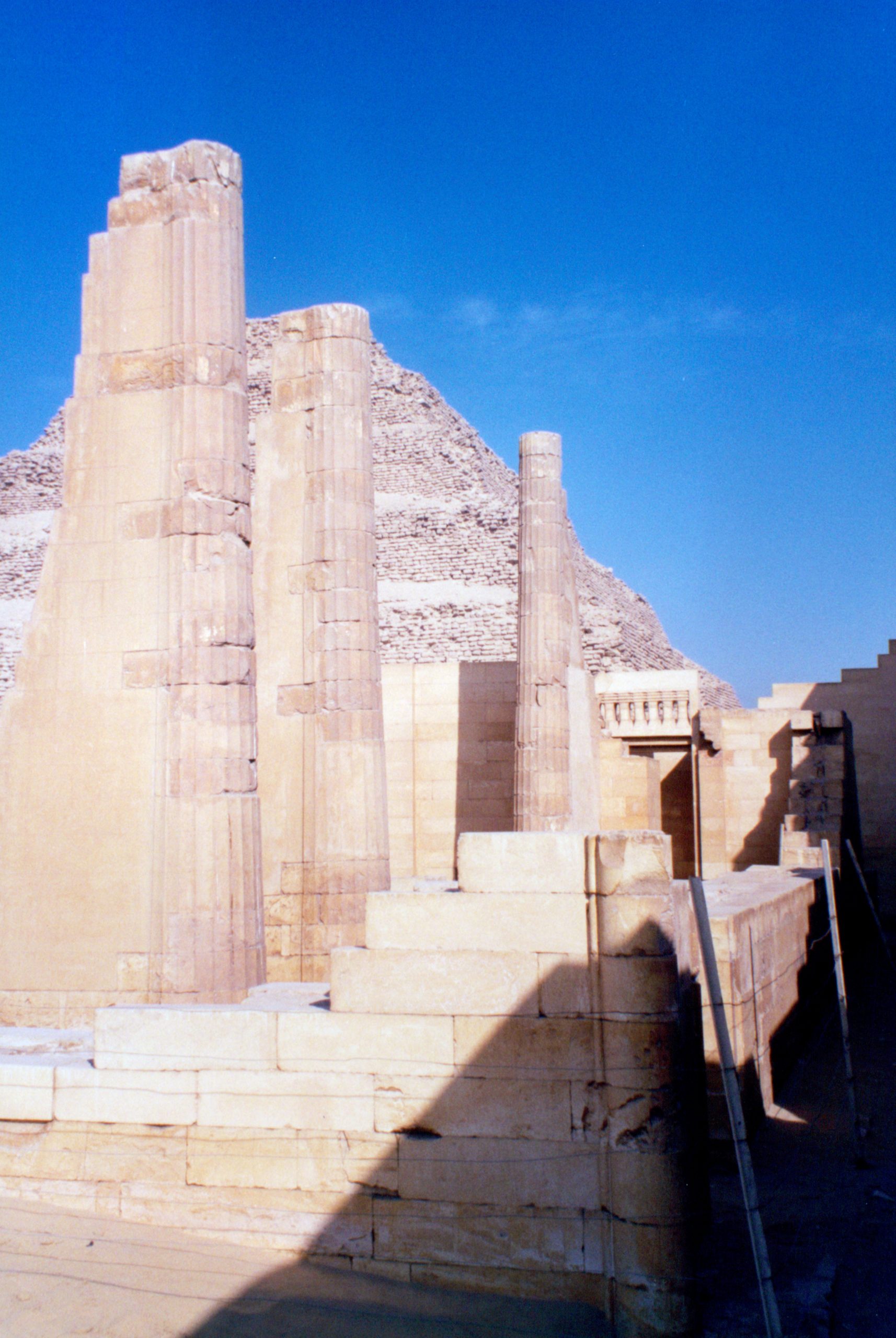
Funerary Complex 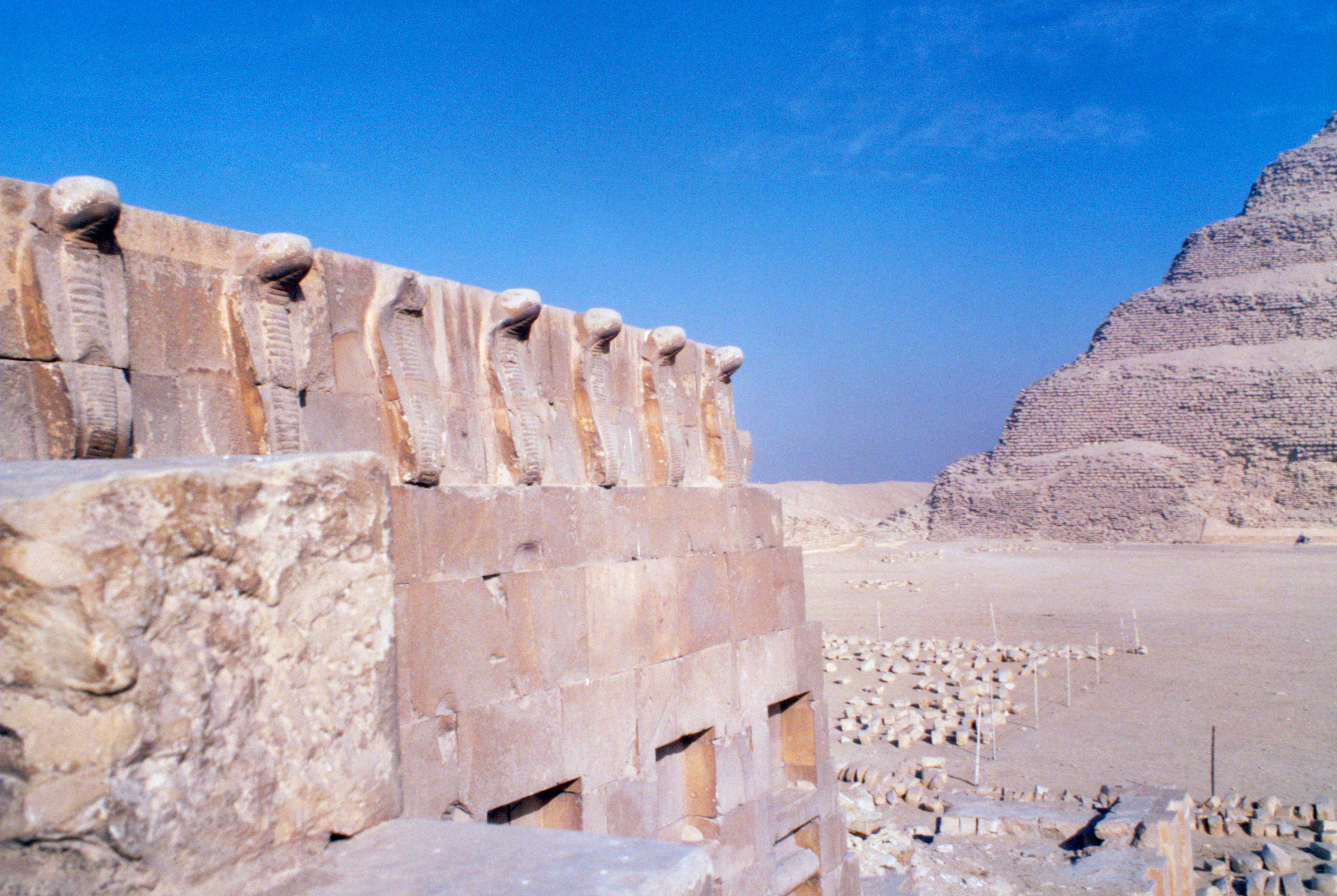
Saqquara
Of course, the dryness and heat of the desert have served to preserve much, though only the stone; little mud-brick remains. I asked one of our guides at one time, why it was that all we ever saw were Temples and Funerary Complexes and she explained that the early Egyptians believed in eternal life after death and that if your time here was to be so short by comparison with your time in the eternal hereafter, it made sense to build funerary and temple structures out of durable material and earthly structures out of cheaper, less important stuff, like mud bricks covered with plaster, beautifully designed and decorated but not built to last.
We were struck by the sharp divide between the green of the Nile and the stark edges of the desert. Sailing down the river the following week, you get the sense of a vast elongated oasis drifting by and, quite often, the desert sands caressing, literally, the very edge of the river.
From Saqquara we visited the Giza complex and were rather upset by perpetual touting and endless harassment from Nagama Bedouin camel drivers to trinket sellers, to offers of photographs and “special guided tours to places off the track”, plus, of course, the eternal cry of “baksheesh!”. Enough to dispel any lingering mystique, though the pyramids themselves are nothing if not impressive. Huge. Until the spires of Cologne Cathedral were completed last century, Cheops held the record as the highest man-made structure on earth!
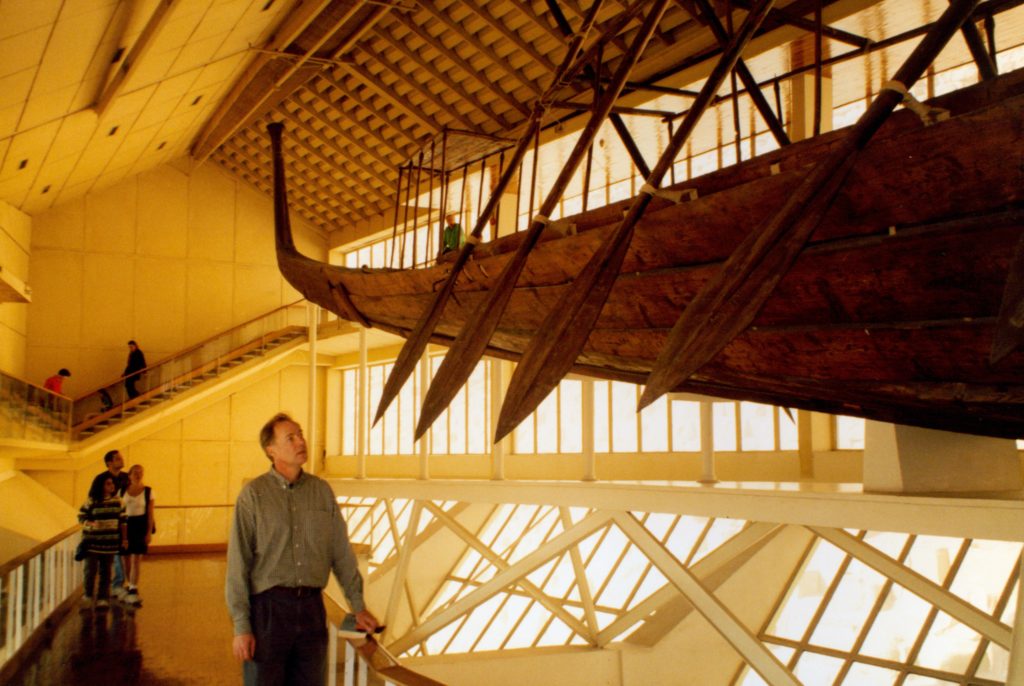
We spent the entire afternoon there and were particularly impressed by the Solar Boat Museum. Perched on the south of the great pyramid of Khufu [Cheops], is a humidity controlled pavilion containing a 43 metre long boat from one of the five boat pits sunk around Khufu.
When the pit’s limestone roofing blocks were removed in 1954, the air was permeated by the faint fragrance of cedar wood. Specialists spent fourteen years rebuilding the graceful craft from 1200 pieces of wood originally held together by sycamore pegs and halfa-grass ropes. The purpose of solar boats is uncertain. Carrying the Pharaoh through the underworld perhaps or accompanying the sun-god on his daily journey across the heavens are two of the many hypotheses.
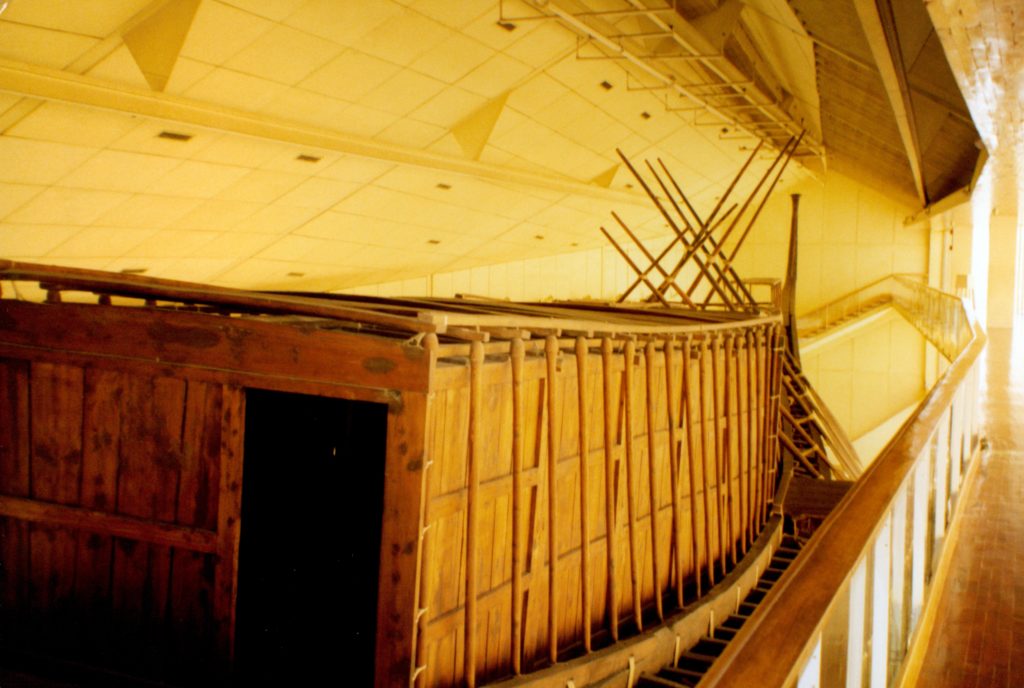
We collapsed back to our hotel for a late lunch by the pool and a swim and vowed to return to the Sphinx at sunset when, because it was Ramadan, we knew we would have the site to ourselves and could, perhaps, soak up some quiet atmosphere.
And we did, but only just: with the muezzins calling the faithful at five o’clock to end their fast, the streets suddenly empty and a quiet descends on the city. We found ourselves on the edge of the desert having walked a strenuous mile up the dunes to the west, the sky lowering in pinks, mauves, reds in a glorious display – the looming shape of Khufu, Chepren and the Sphinx standing guard in all their mystery over our civilization as they have done for so many thousands of years – a moving moment shattered by the sudden appearance of an “antiquities official” resplendent in gellabiyah and turban and brandishing an identity card, to inform us that we were trespassing on the sight and must please leave.
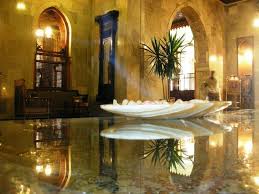
Mena House Hotel 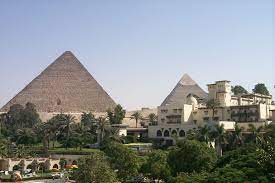
Mena exterior
We treated ourselves to dinner at the famous Mena House Hotel in Giza that night. Set in lush grounds near the pyramids, this one-time khedival hunting lodge witnessed Roosevelt and Churchill initiate the D-Day plans and the formal signing of the peace treaty between Israel and Egypt. Its renovated arabesque halls and 19th century rooms are delightful.
We walked back to our hotel and were promptly hi-jacked by a perfume manufacturer who managed after and hour and half to sell me some lotus oil essence at vast expense. It was worth it just witnessing his quite incredible sales pitch!
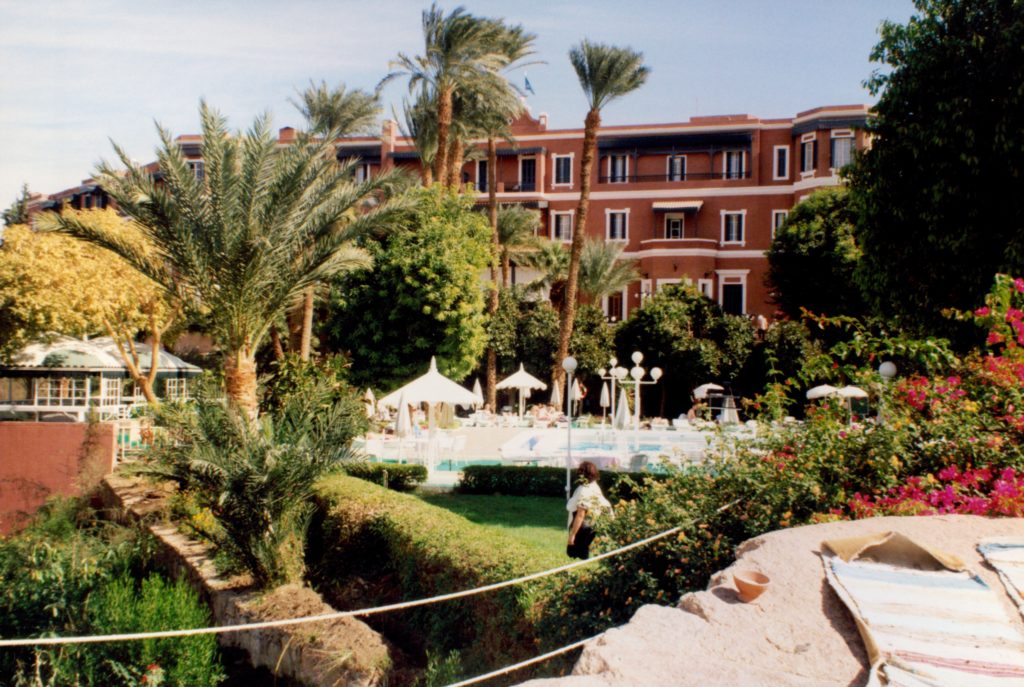
On the Wednesday we flew to Aswan for a four day stay at what must be one of the great hotels of the world – the Old Cataract Hotel. An Edwardian-Moorish relic, built on a grand scale by a Swiss company in 1900, beautifully refurbished – down to the original creaky ascenseur; river facing rooms with glorious views to the west over Elephantine Island, across the lush
valley to the desert massif, the Aga Khan’s tomb dominating the skyline, the ceaseless flow of gently drifting feluccas, like gliding quills on the water, shimmering by.
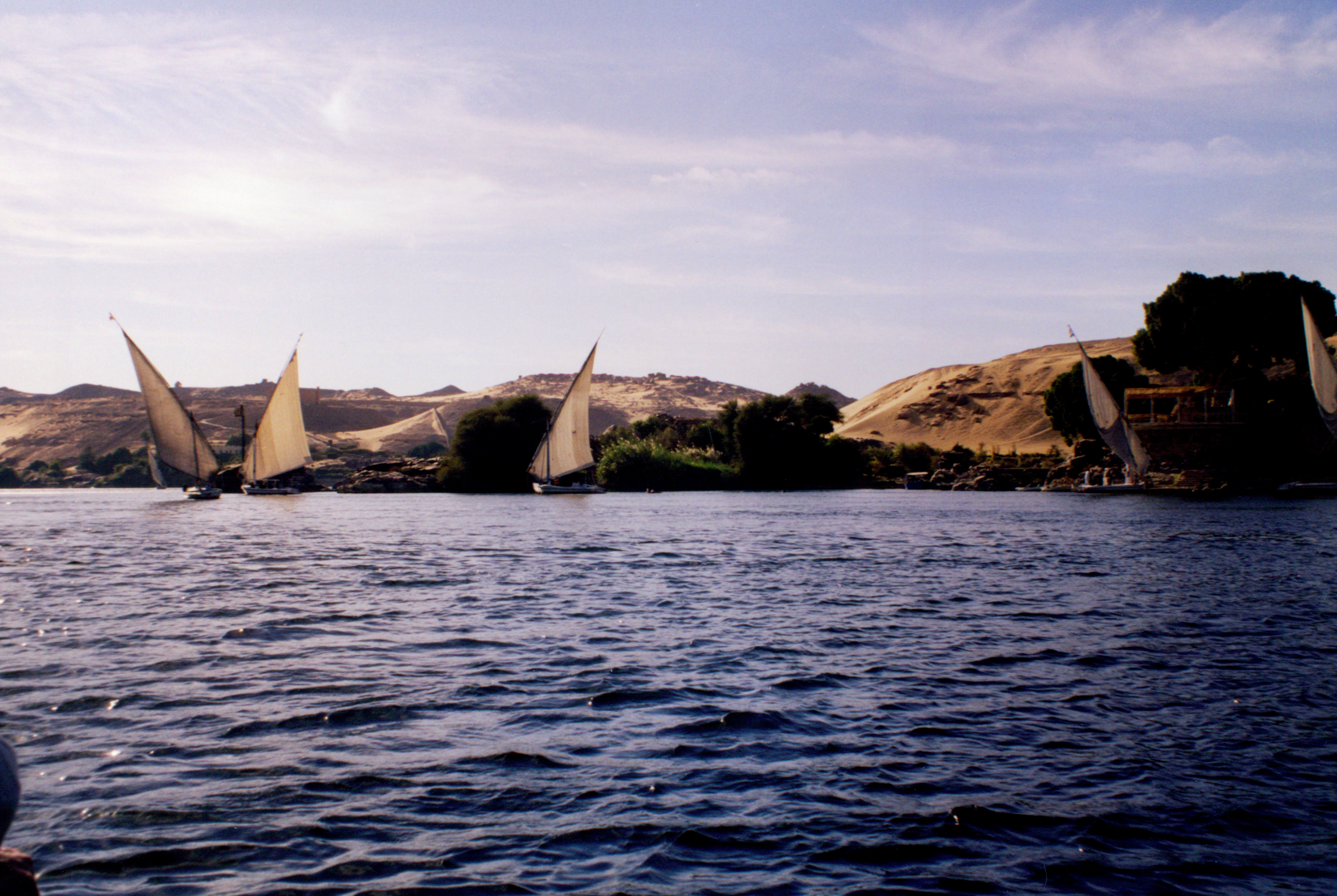
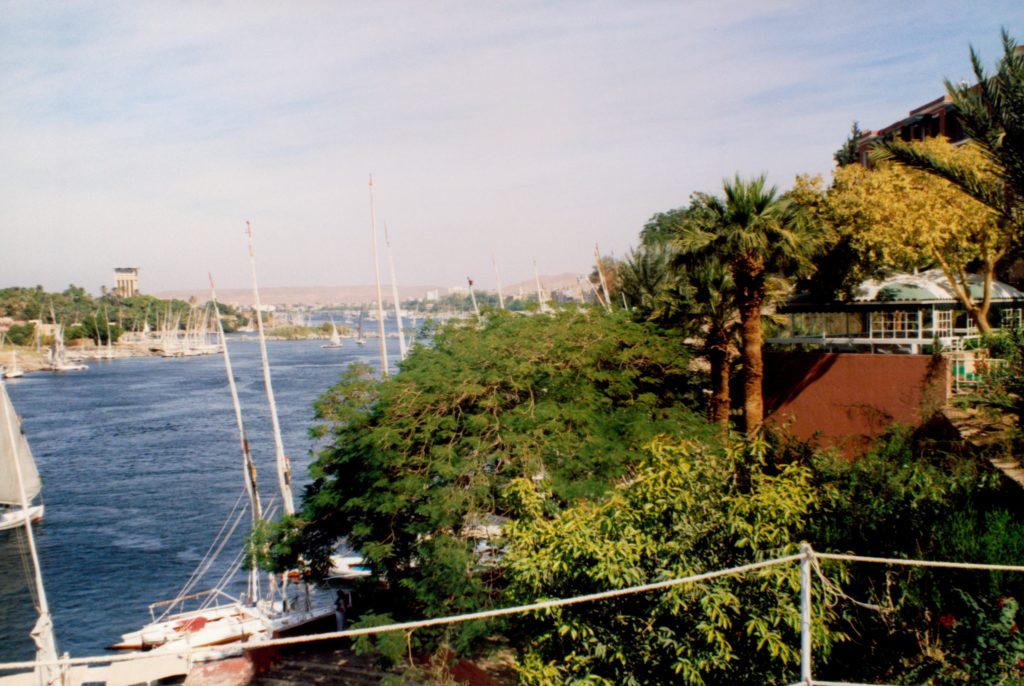
Room with a View 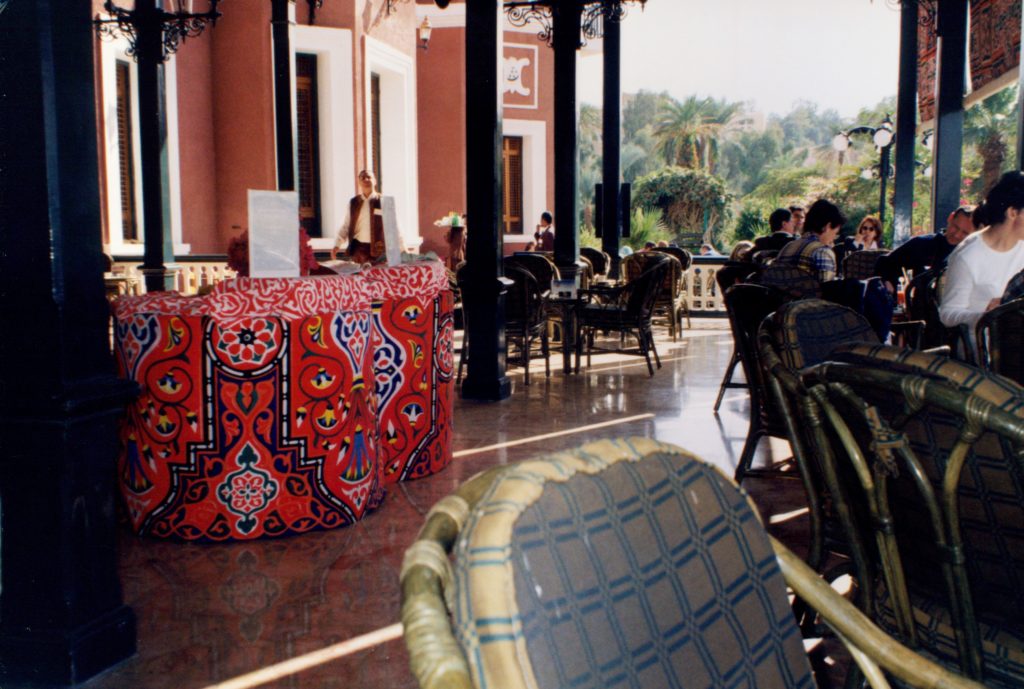
The guest list is like an historic march through the 20th century: Kitchener, Churchill, Khrushchev, Agatha Christie, endless Kings, Queens, Lords, Ladies, Prime Ministers, Presidents and, not least, King Farouk himself, have stayed there. The 1902 Restaurant, where we had breakfast each morning, an event in itself.
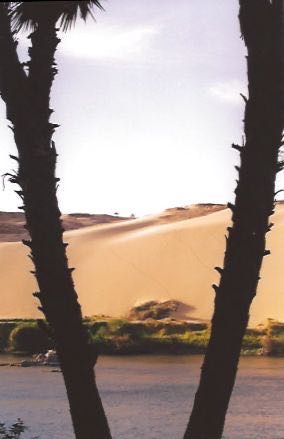
We spent time just relaxing by the pool and reading. But also hired a felucca to take us up to the first cataract and to visit a Nubian village on Sehel Island where we were entertained by two elders to tea. Into the town each evening to find local food and see the bazaar. But the highlights were our visit to Philae on its sacred island on the smaller, old Aswan Dam and, of course, our special flight up over the vastness of Lake Nasser to the gigantic and rescued Temple of Ramses II and his Queen Nefertari at Abu Simbel. This entailed a thirty minute flight to cover the 280 miles from Aswan up to the site – a spectacular monument to man’s ingenuity on two counts – the actual temples themselves and the way they were dismantled and raised 61 metres
in the 1960’s as the Nile backed up behind the new High damn which Nasser built with the help of the Russians: you may remember the plight of “the amorous Hippopotamus whose love song we know…..” ?
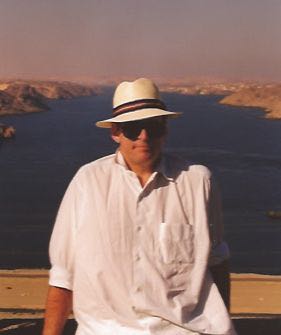
At Aswan Dam

Apart from the chattering Italians who increasingly became the bane of everyone’s lives with their perpetual racket and insensitive behavior, the trip was a huge success. Abu Simbel epitomises the monumentalism of the so-called New Kingdom during its Imperial heyday (BC1304) when Ramses II reigned. To impress his power and majesty on the Nubians and any others from primitive sub-Saharan Africa who might get ideas
above their station, he had four great statues of himself hewn from the mountainside, whence his unblinking stare confronted travellers as they entered Egypt. It was precisely oriented [that word again, Dad!] so that the sun’s rays reached deep into the mountain to illuminate its sanctuary on his birthday and the anniversary of his coronation.
We were impressed not only by the statues and sculptures themselves but also the impressive feat of actually shifting them there while the river flooded. Quite a lot of monuments all down the valley were saved in this way; though they are difficult to visit at the moment being rather isolated; you really have to be on a Lake Nasser cruise to see them and those are few and far between and rather more expensive.
We stumbled onto two, unobtrusive grey doors in the mountainside beyond the northern colossus where we found air-conditioning and stairs leading up into a vast concrete dome, ringed by a steel cat-walk and completely deserted. Displays here showed us how the temple was removed from its original site and reassembled beneath this dome which was then covered with landfill to create a false mountain. Like a gigantic James Bond set, it reminded me of the launch mountain in You Only Live Twice! The revelation was just as startling as Abu Simbel itself.
14th January.
Thank you so much for your call last night. As you can see, this epistle is taking some time. There is such a lot to tell so I had better just get on with it!
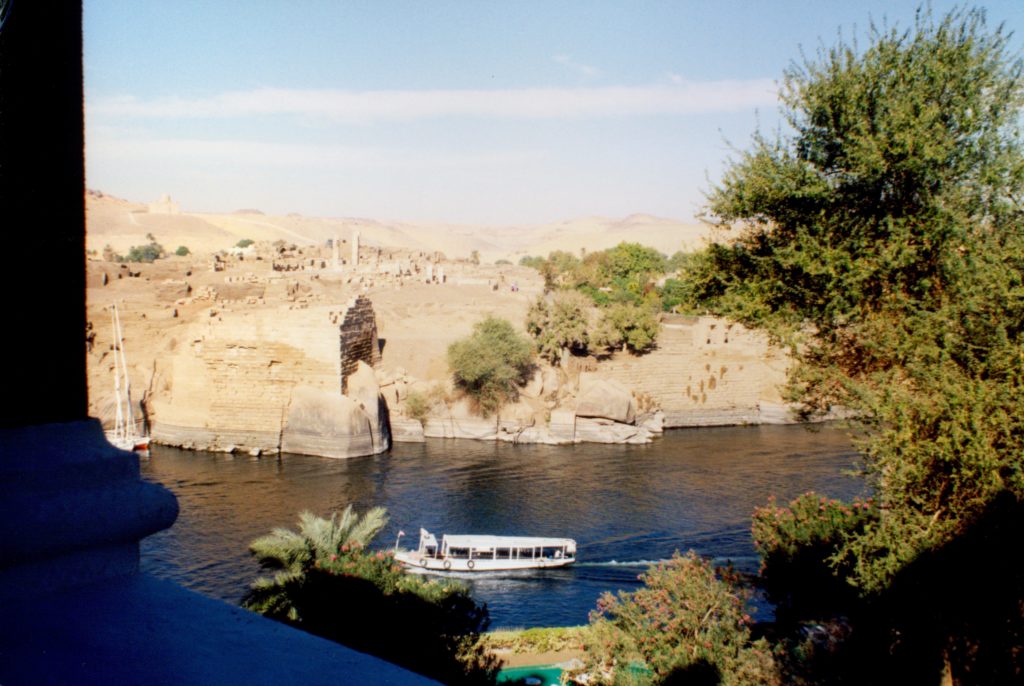
The other interesting visit we made under our own steam was to the Son et Lumiere at Philae with its Temple of Isis which has bewitched visitors since Ptolemaic times when most of the complex was constructed; it certainly bewitched us. The Sound and Light show we visited on a crisp clear night, is better than the one at Karnak due to its island setting. It consisted of an hour long tour through the ruins whose floodlit forms are more impressive than the melodramatic soundtrack.
After the building of the first Aswan Dam, rising waters lapped and surged about the temple, submerging it for half a year and visitors would admire its shadowy presence beneath the translucent water. When the new High Dam was built it became apparent that it would be submerged forever and UNESCO and the EAO [Egyptian Antiquities Organisation] organised a massive operation to relocate the temple on nearby Aglika Island landscaped to match the original site. The new Philae is magnificently set amidst volcanic outcrops, “like a jewel in a royal blue lake – but no longer faces Biga Island, sacred to Osiris, whence its holiness derived.” We visited the site again during the daytime when our cruise returned to Aswan the following week and it was just as beautiful then.
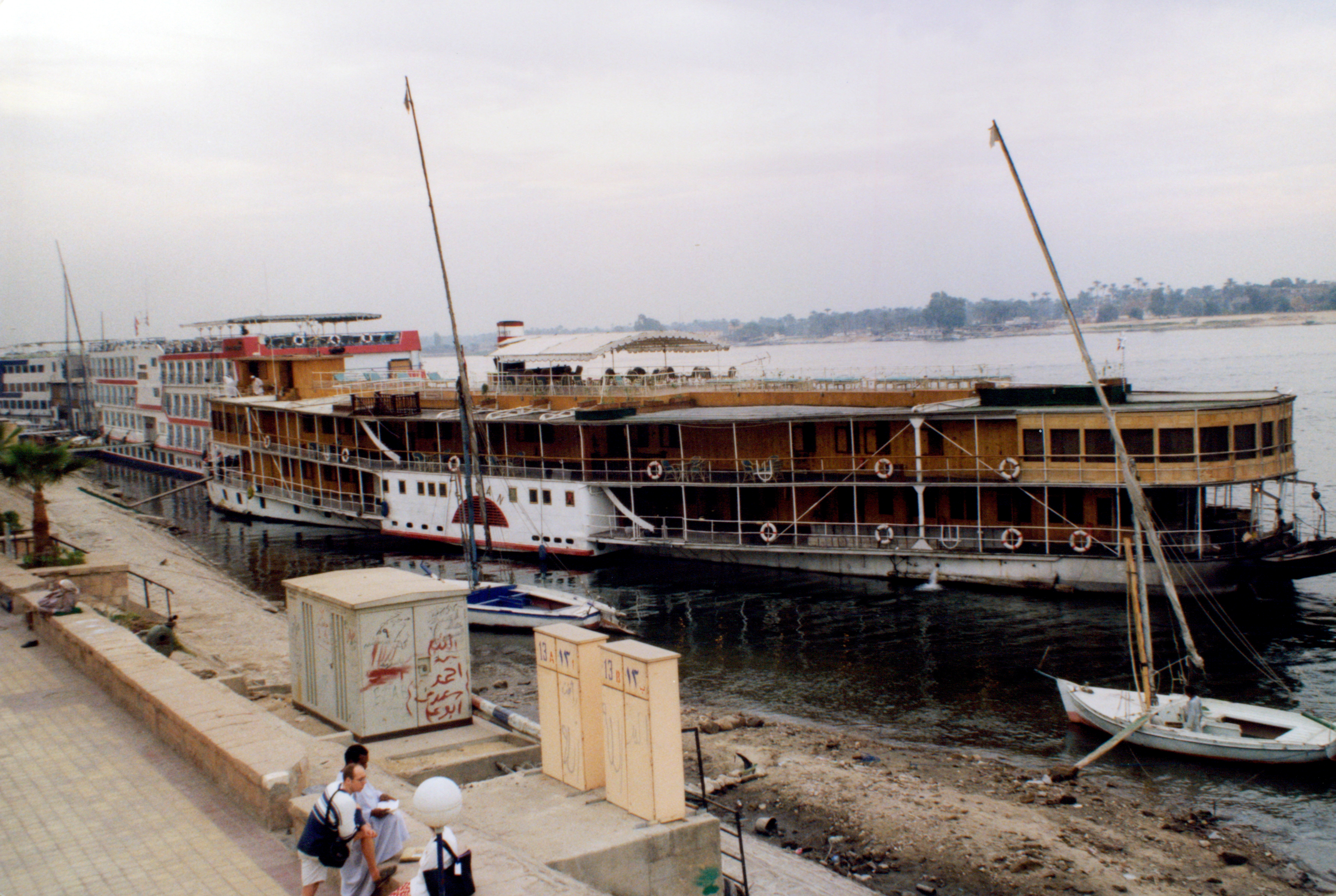
On Sunday evening we flew to Luxor, booked a hot-air balloon flight over the Valley of the Kings for early the following morning and checked into our hotel, bog-standard Etap Mecure, facing west onto the river and a wonderful old Paddle Steamer, the Sudan, berthed in front of us. Death on the Nile was filmed on it and, once
belonging to King Farouk, it is one of two original paddle-steamersoperating in luxury style up and down the river. Now on diesel but I saw the other one, dating from 1917 which came bustlingimportantly into Aswan the following week, belching steam and clanking its rods. Marvelous.
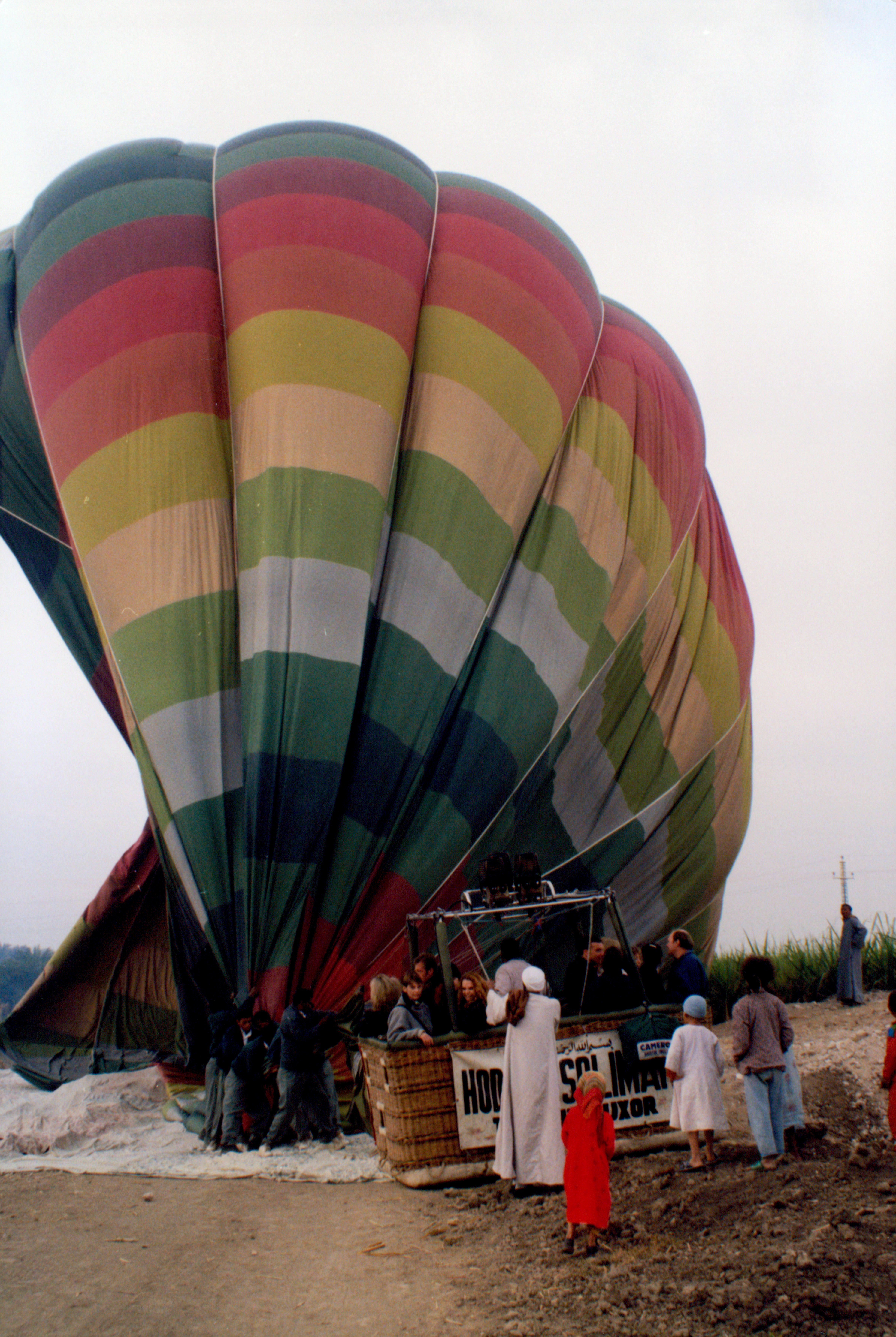
The hot-air balloon was fun. We were fetched at 4.45am from our hotel, ferried across the river, to join the flying team. A suitable site was found, all wind directions tested and we watched in wonder as this vast canopy of silk [or some similar substance] engorged into life from which was suspended a container that looked rather like an enormous wine-bottle basket with little compartments into which seventeen of us were crammed! I kid you not.
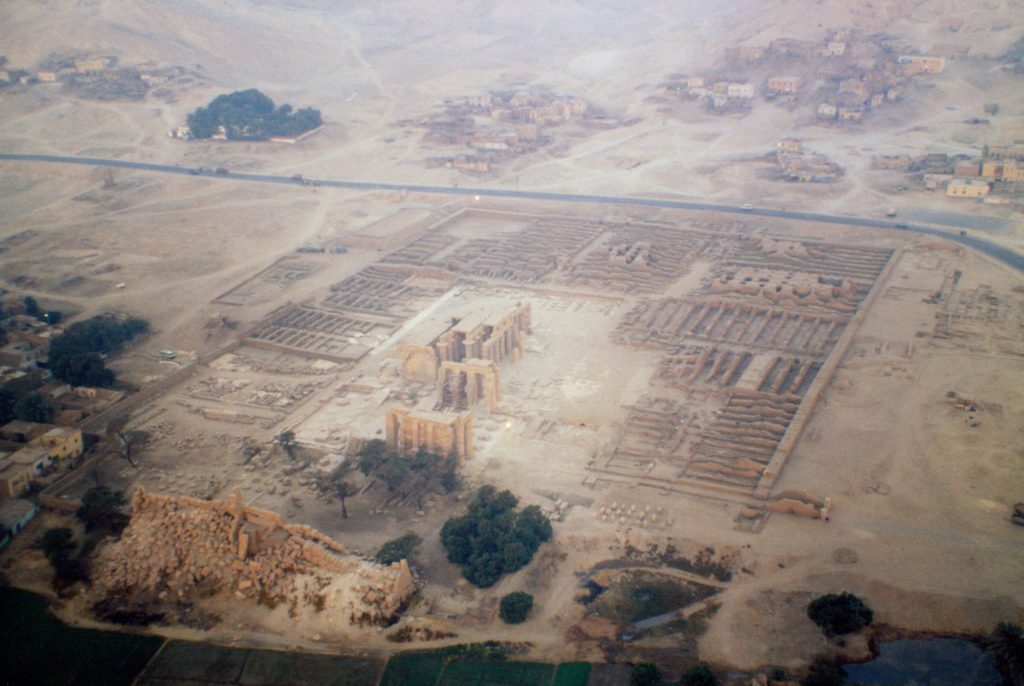
Valley of the Kings: 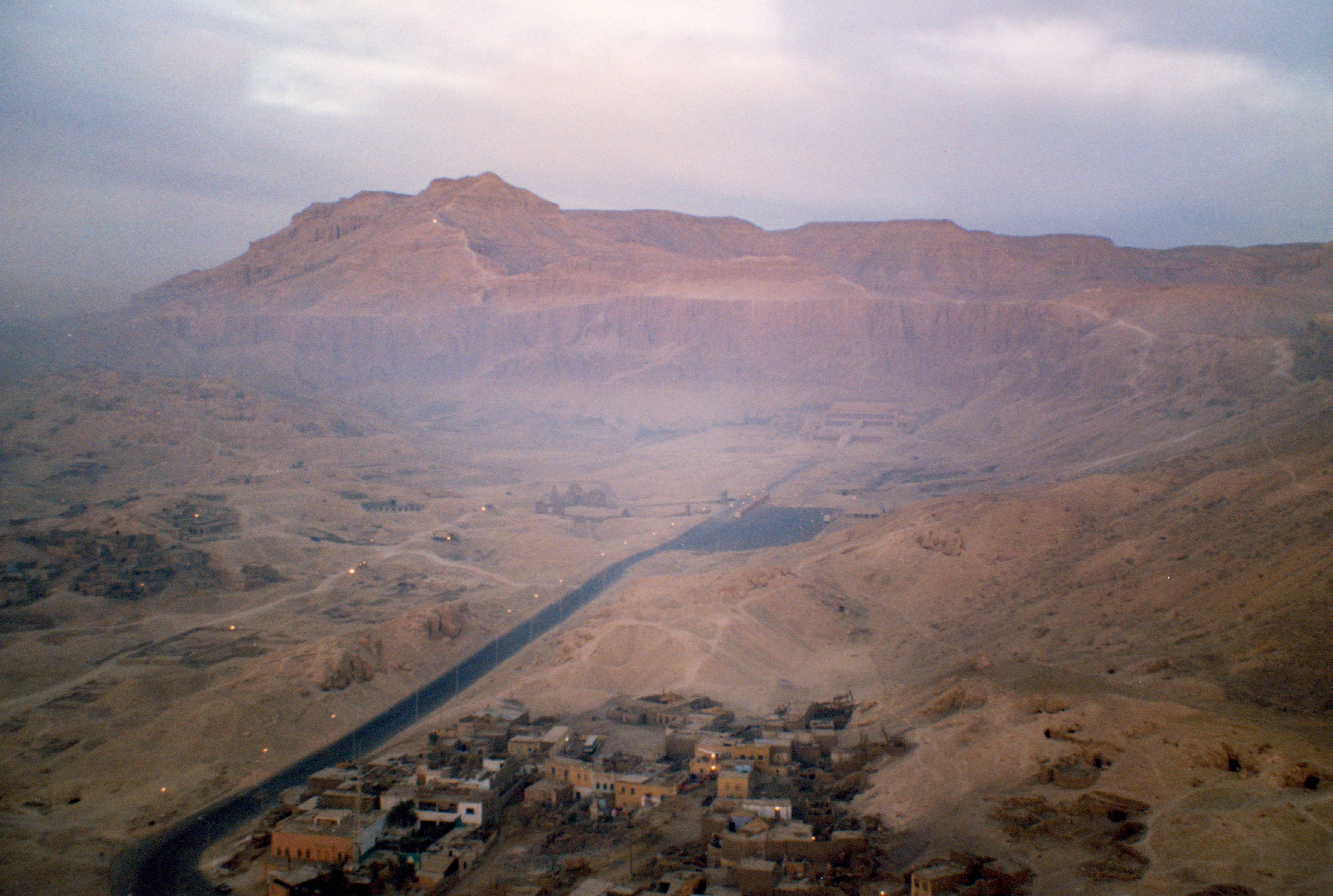
Luxor
And very slowly, ponderously and gently we wisped into the ether and for an hour and half [and at vast expense] floated along the edge of the desert, following the escarpment of the greatest funerary complex of all – The Valley of the Kings, The Valley of the Queens, Hatshepsut’s temple [where 69 tourists were gunned down just last year], The Tombs of the Nobles, The Tombs of the Workers [very important and brilliant these.
The pharoanic authorities spent much money and glory on them because they were the ones who made all the architecture and artwork possible], The Ramesseum, the mortuary temple of Ramses II, a gigantic temple based on the conventional Pylon, halls and vast inner sanctuaries which were a format design for temples large and small then; Medinet Habu, the gentler, more impressive mortuary temple of Ramses III and, finally the glorious, dignified though damaged Colossi of Memnon rearing 18 metres above the sugar-cane fields, a gigantic pair of enthroned statues, their faces and crowns lost in time but bearing a majesty and mystery that stops one in one’s tracks.
Our balloon man tried to land here but was let down by his ground crew who had been tearing around in their van following us. A vital rope went astray and we had suddenly to swoop up and away, narrowly missing some high tension cables and finally landing rather violently and tipping right over on the edge of a large reservoir bounded by a small sugar-cane railway track, a canal, tension cables and phone lines. Thousands of joyful children who had seen us from the ground chased after us to celebrate our landing, dance for us and hope for much baksheesh! Which they duly got because Arab children are even more adorable-looking than black kids! What an adventure.
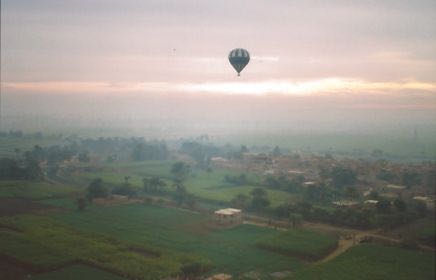
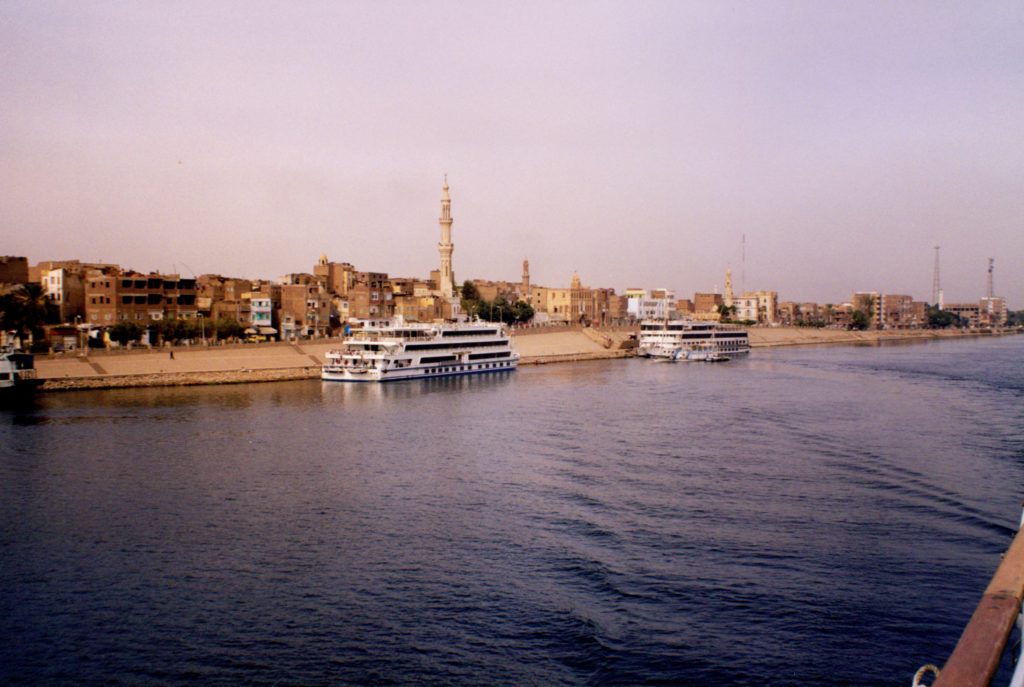
That same morning we returned to our hotel to pack up and be transferred to the MS Royale our river cruiser and home for the next seven days. She was berthed opposite the Winter Palace Hotel, another grand European construction dating from 1886. Most of the passengers were present by dinner when we were
introduced to our two guides, Sally and Fatma and divided into two groups of about 25. Fatma was our guide. Both ladies were Egyptologists and spoke fluent English. Fatma was a lovely person. On our first morning she took us to Karnak, the biggest of all the Temples on the Nile, with a coherent commentary and a concise lecture “contextualizing” everything – if I can employ such a clumsy word. Later to the smaller and lovelier Luxor Temple right by the river and near our boat – after which we adjourned for lunch and set sail at about 2.15pm to spend the afternoon gliding gently Southwards, up along the rich bank-side farmlands with the desert always in the frame, towards the great barrages and locks at Esna for our first stop.
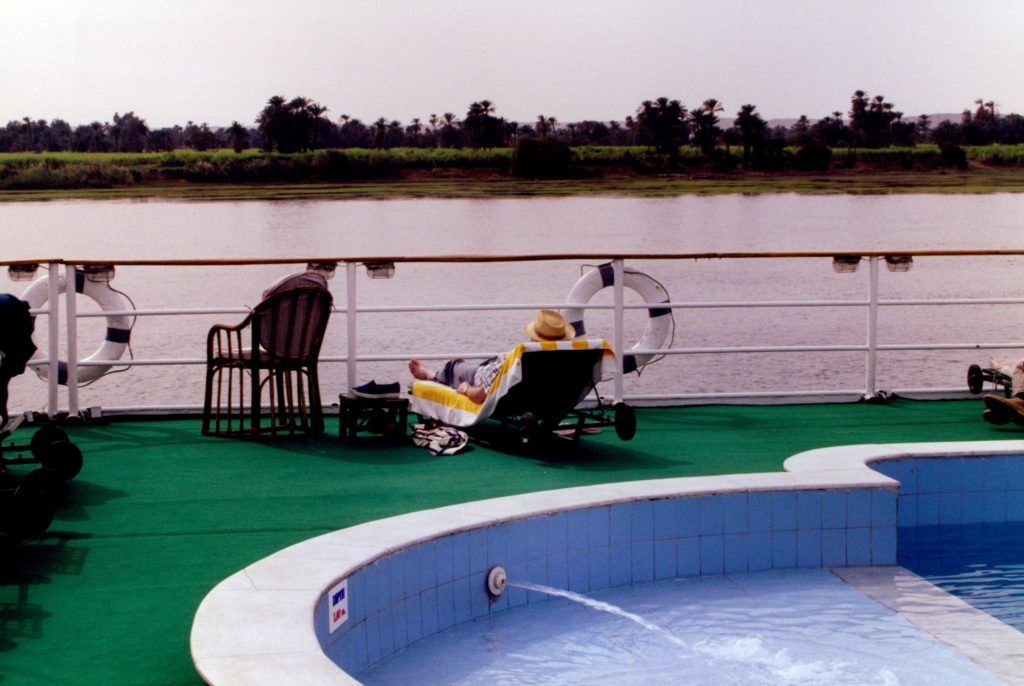
The boat was lovely. Tastefully appointed, it [and its sister ship, the Regency] were built in 1992 in the boatyards at Alexandria and then fitted out on the river in Cairo. Apart from the Caterpillar engines and bathroom fittings, all from America, everything was Egyptian. Three engined with variable-pitch screws and three generators for electrical power, they are capable of moving pretty quickly up and down the river though for the purposes of our timetable, they weren’t using all their capacity. We heard, and judging from the many other boats we saw and walked through [boats moored alongside each other at night and were lined up so that you could walk through them to the dock.] that our two boats were among the best on the Nile. Not overcrowded, with excellent facilities, five floors comprising the bottom floor where our cabin was on the waterline and containing a large bedroom and bathroom with an enormous picture window looking out across the water. Along from our cabin was a small shop and a large foyer leading into the dining room. Up the grand staircase, you reached the reception area, passages leading to more cabins and the wheelhouse, the purser and the doors out onto the gangways when we were berthed.
Up another flight to more cabins and yet another flight to a large, comfortably appointed drawing room, dance floor and bar and an snug viewing gallery and bar at the front, immediately above the wheelhouse with wrap-around picture windows, glazed for the glare and of course, fully air-conditioned. A door let out onto the afterdeck which was furnished in cane and canopied against the sun; a staircase taking you up to the sun deck complete with loungers, low tables, swimming pool, pool deck attendants, towels etc etc.
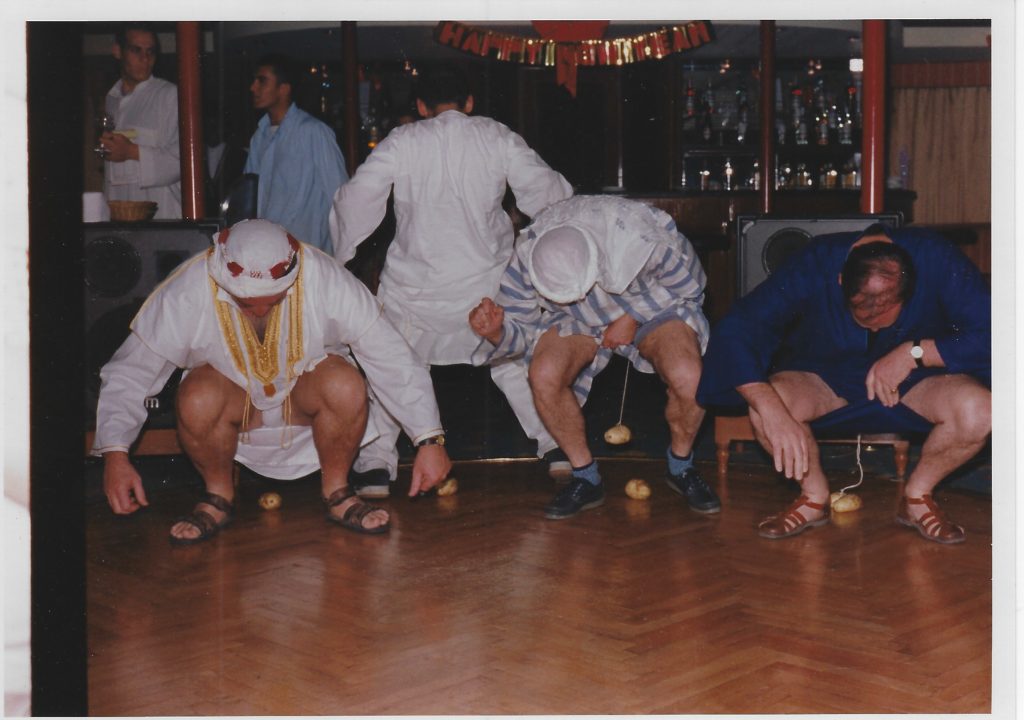
Don’t ask! 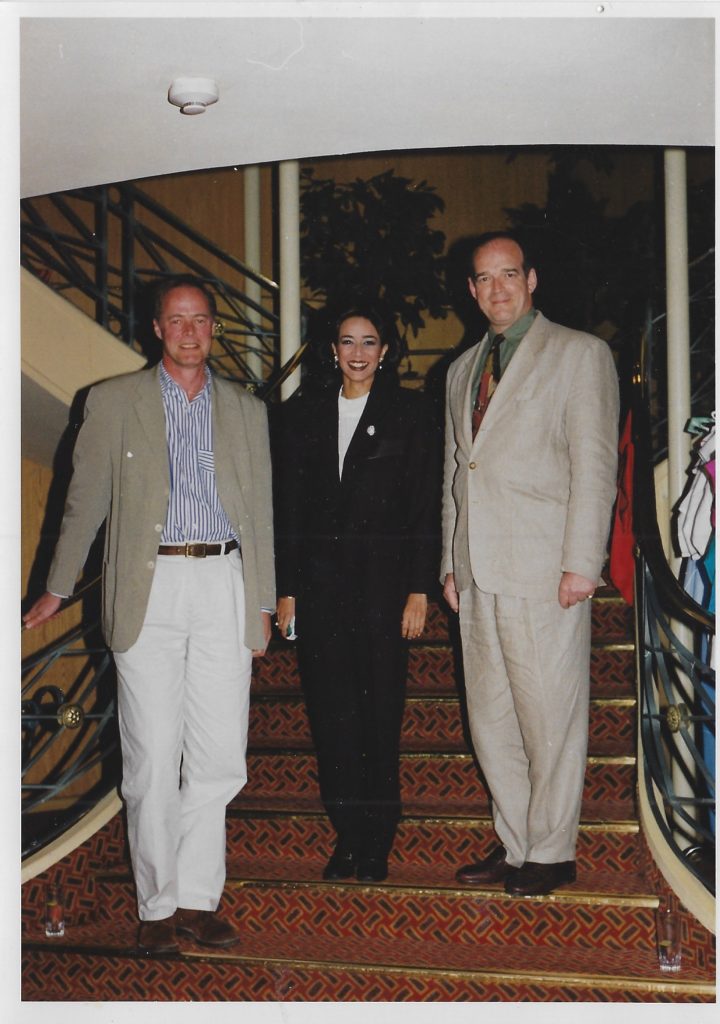
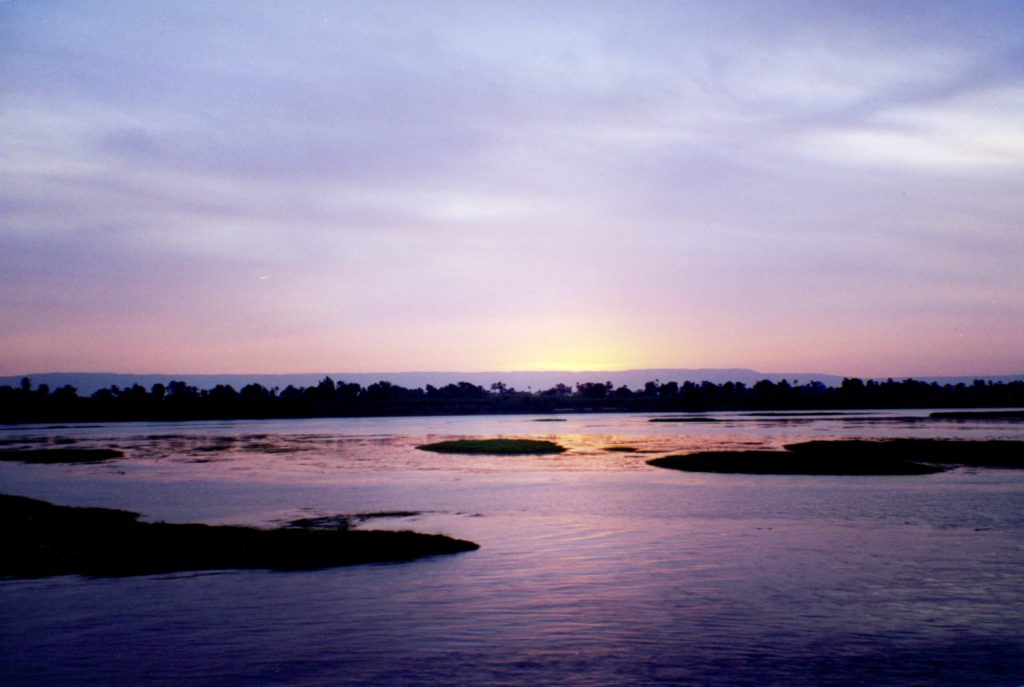
So – very comfortable and a lovely sensation just cruising quietly along to our destinations. Mind you, you needed the rest to prepare you for the next battle with the Italians!

At Esna small town life and ancient stone are boldly juxtaposed where a huge pit in the centre of the town exposes part of the Temple of Khnum excavated in the 1860’s when it was “buried to the chin in the accumulated rubbish of a score of centuries” and built over with houses. So they are ten metres below ground level and look like a sort of pharaonic Fort Knox!
We walked back through the village and haggled in the bazaar; bought some lovely shawls and I wanted a Scarab beetle for luck – or a soapstone carving of one, at any rate! Returned to the boat in time for morning tea and set off up-river to reach Edfu in time for lunch. Then we were taken by horse and carriage to visit the astonishing [in that it is hardly ruined at all] Temple of Horus, arguably the best preserved of all the Temples in Egypt though we would have adored to go to Abydos where, we understood, we would have been even more impressed. But parts of middle Egypt are not exactly out of bounds, but certainly the authorities discourage the tour companies from going there because of the Fundamentalist activity. If we had been lone travellers, we certainly would have gone. Be that as it may……now let me tell you some unpleasant facts and put the Italians into context!
The trouble with these boats is that they all arrive at these sites simultaneously! This means that although each boat is a comfortable size [there were 80 of us on ours – about 40 Germans and the rest, English], when twenty or more river craft berth at a small town like Esna or Edfu, they are disgorging potentially 1700 tourists at the same moment. This is madness. The sites, from being deserted and peaceful one moment, are suddenly overwhelmed the next and we got quite depressed coping with this fact. Most groups are disciplined and sensitive to the situation……….
Here I make some rather stereotypic observations quite out of keeping with the sentiments of the 21st Century so I have redacted!…………
……………..[but] by lingering a while afterwards, we were able to watch these sites empty as fast as they filled and could enjoy perhaps a shred of the mystery and wonder echoing in their halls……..
…….More naughty comments mainly about Italians which had to go!……….
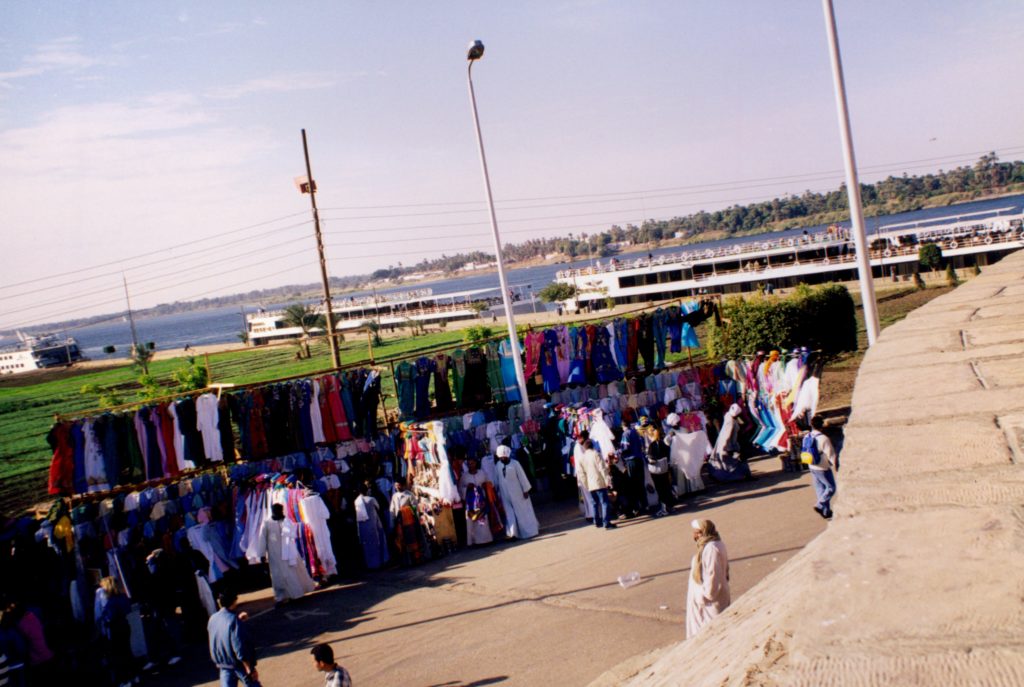

After the wonderful Temple of Horus at Edfu we cruised all afternoon, swimming and reading and sleeping and finally G & T-ing before showering, changing and dining – docking at Kom Ombo for the night and ready for the early morning walk to visit the Temple of Haroeris and Sobek, the crocodile-headed god.
There we found hieroglyphic revelations of early Egyptian medicine and surgery that staggered us. Did you know that they were familiar with complicated, invasive surgery like trepanning? That they could remove simple tumors from the brain? And I could go on listing many other things that modern medicine has only started getting to grips with in the past 150 years! Amazing.
But on we must go, otherwise this letter will never be finished!
We returned to our boat and by lunchtime could see the Oberoi Hotel and its ugly tower riding high over Elephantine island in the distance as we approached Aswan.
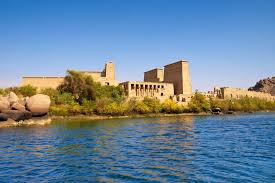
After lunch, visits to the unfinished obelisk [extremely interesting to see how they were made. A single piece of granite you know, hewn out of the rock. I can’t go into the details here of how they lifted them, moved them to the river, floated them downstream, erected them – its all too complicated and staggering], the Temple of Isis at Philae – in daylight for us now – and
then to the High Dam, strangely unimpressive considering the impressive construction statistics.But it doesn’t have a wall like Kariba. Considering its vastness, you want the wall that creates this vastness to look high, precipice-like and impressive. But its not like that: more like a very long rampart – you could walk down either side easily and though it backs

up the Nile into the biggest reservoir in the world, 500kms long, 6000 sq. kms, 180 metres deep in places. Security is tight. It is calculated that if the wall were to break, most of the population of Egypt would be washed into the Mediterranean. The surrounding hills bristle with radar and anti-aircraft missile installations.
The pros and cons of the dam are being argued to this day. It undoubtedly has helped control the damage of flooding and provided water during famines; it certainly has created millions and millions more hectares of arable land; generated vast supplies of hydroelectric power for industry and so on but its detractors say that it is an environmental catastrophe. Silt is no longer deposited naturally onto the land and dangerous Nitrokima fertilizers have to supplement the earth and these have entered the food chain. Soil salinity has increased and can only be prevented by expensive drainage projects – these in turn provide breeding grounds for mosquitoes and bilharzia-carrying snails. Ancient monuments [and tourism is by far their biggest forex earner] have been affected by damp and salt encrustation, blamed on the rising water table and greater humidity; some think this has made Egypt more vulnerable to earthquakes and with no silty deposits to replenish it, the Delta coastline is rapidly being eroded by the Mediterranean. It is estimated that the lake itself will fill with silt within 500 years [could we care less at this distance!?]
And then there are the political ramifications: some reckon that the Nubian desert may have reverted to its prehistoric lushness by then, others fear international conflicts over water resources within the next century. Civil Wars have prevented Ethiopia and Sudan from harnessing the White Nile and the watery Sudd for their own needs but Egypt has already expressed its objections citing a vested interest in the Nile’s head waters and it is prophesied that the country will go to war over the Nile in the next century.
All this underlines the importance of this age old river, its vast history, its wealth, its incredible length, its power and magic. To understand it just a little, is to bring one closer to understanding just a smidge of its extraordinary story.
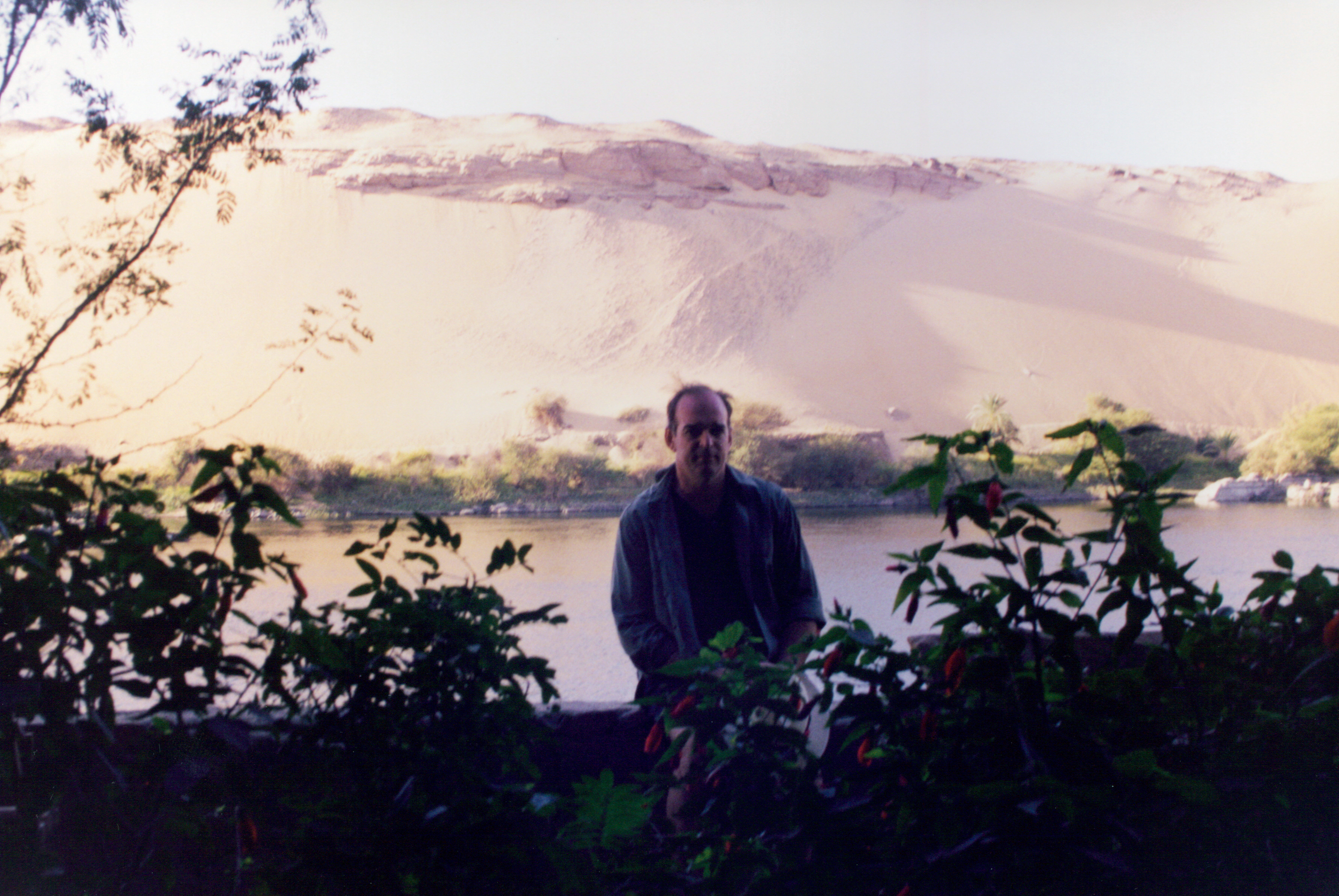
On the Friday morning most of our company went off to Abu Simbel while we were at leisure because we’d been there the week before. I think we lolled around the swimming pool and then lunched before joining a felucca taking us to spend the afternoon on Kitchener’s Island: a lush little island given over to hundreds of botanical exhibits planted there by Kitchener when it was presented to him in gratitude for his military exploits in the Sudan and he used it to indulge his passion for exotic flora.
Now its called Geziret an-Nabatat and is a lovely botanic garden – the harsh grandeur of the western desert reaching right down to the water’s edge contrasted with the lushness of this little oasis three hundred yards off – like a stately galleon snubbing a giant super-tanker.
On Saturday we spent the whole day returning to Luxor. Entertainments were offered every night on board – the usual sort of things: fancy dress, games, dancing and so on but the highlight was a whirling dervish that came to entrance us. How they don’t just whirl their heads right off I cannot imagine. He whirled non-stop for literally ten minutes, creating marvellous patterns with his garments.
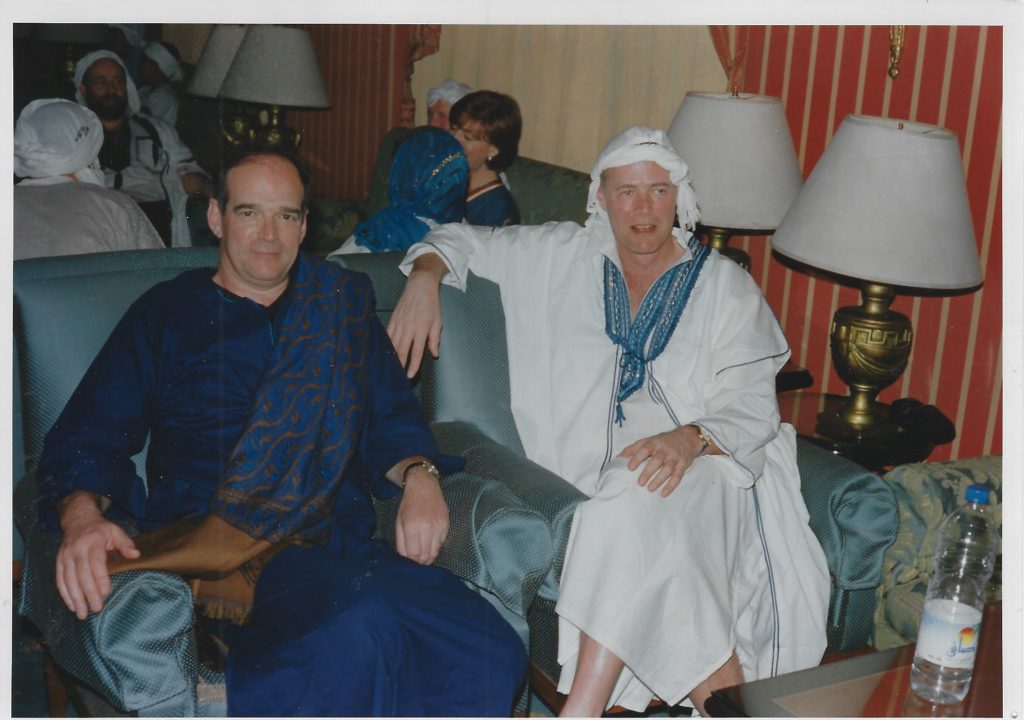
New Year’s Eve on board……… 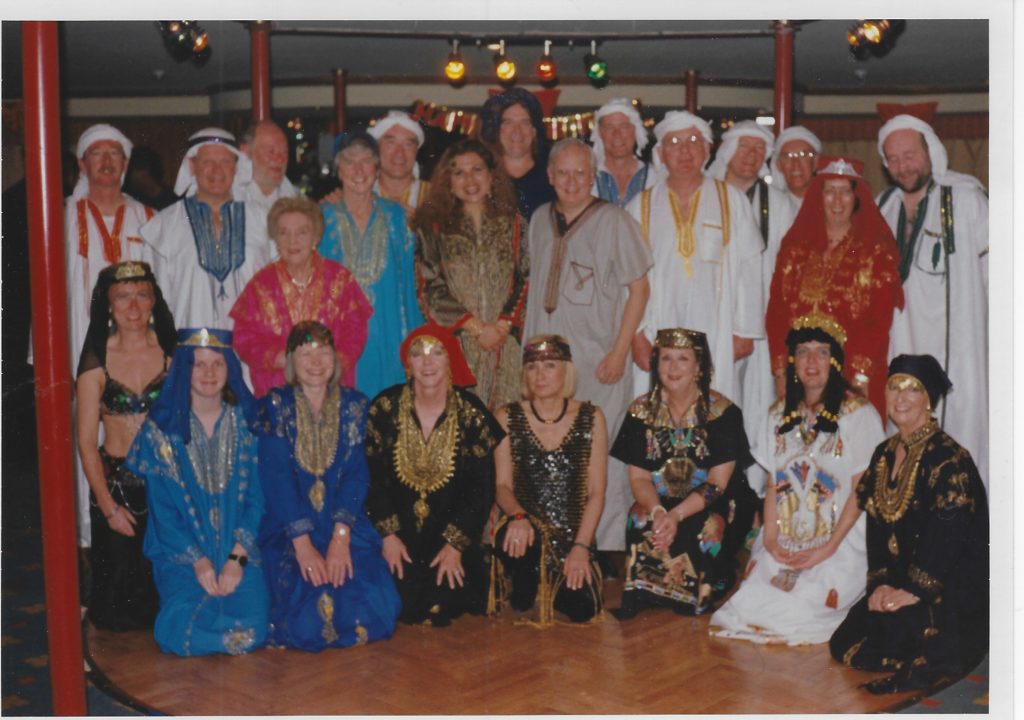
….are we cringing?
Having reached Luxor late on the Saturday night, we prepared for our last excursion on the West bank on the Sunday morning and now, with our balloon trip as a background, we visited the Valley of the Kings and all the other funerary complexes, on the ground. It was fascinating.

I thought that by then I would be unable to take in any more surprises or, even, be surprised at all! But among many delights that day, I visited the Tomb of Queen Nefertari, Ramses II’s wife. Discovered in 1989 and after years of work cleansing its reliefs of salt deposits and stabilising the plaster work, Queen Nefertari’s tomb looks fabulous – almost as if the artist has only this minute washed his brushes and put away his paints. It is overwhelming and I was moved to tears. The tomb is so fragile that only 150 visitors a day are allowed, in very
small groups of ten and for ten minutes only for fear of the damage the very condensation our breathing generates, will create. Tickets are sold under strict supervision and on a first-cum-first-serve basis. They are expensive too @ £E200 each [or GBP£35.00 at prevailing rates] – our group, despite our early arrival, were only able to secure 14 tickets which worked out at one per partnership. Tony kindly let me go and it was quite simply one of the highlights of the whole holiday. My reaction being rather like that I experienced on first seeing some of the other wonders of the world when I was 16 and first in Europe: St. Peters, the Sisteen Chapel, the Prado and so on.
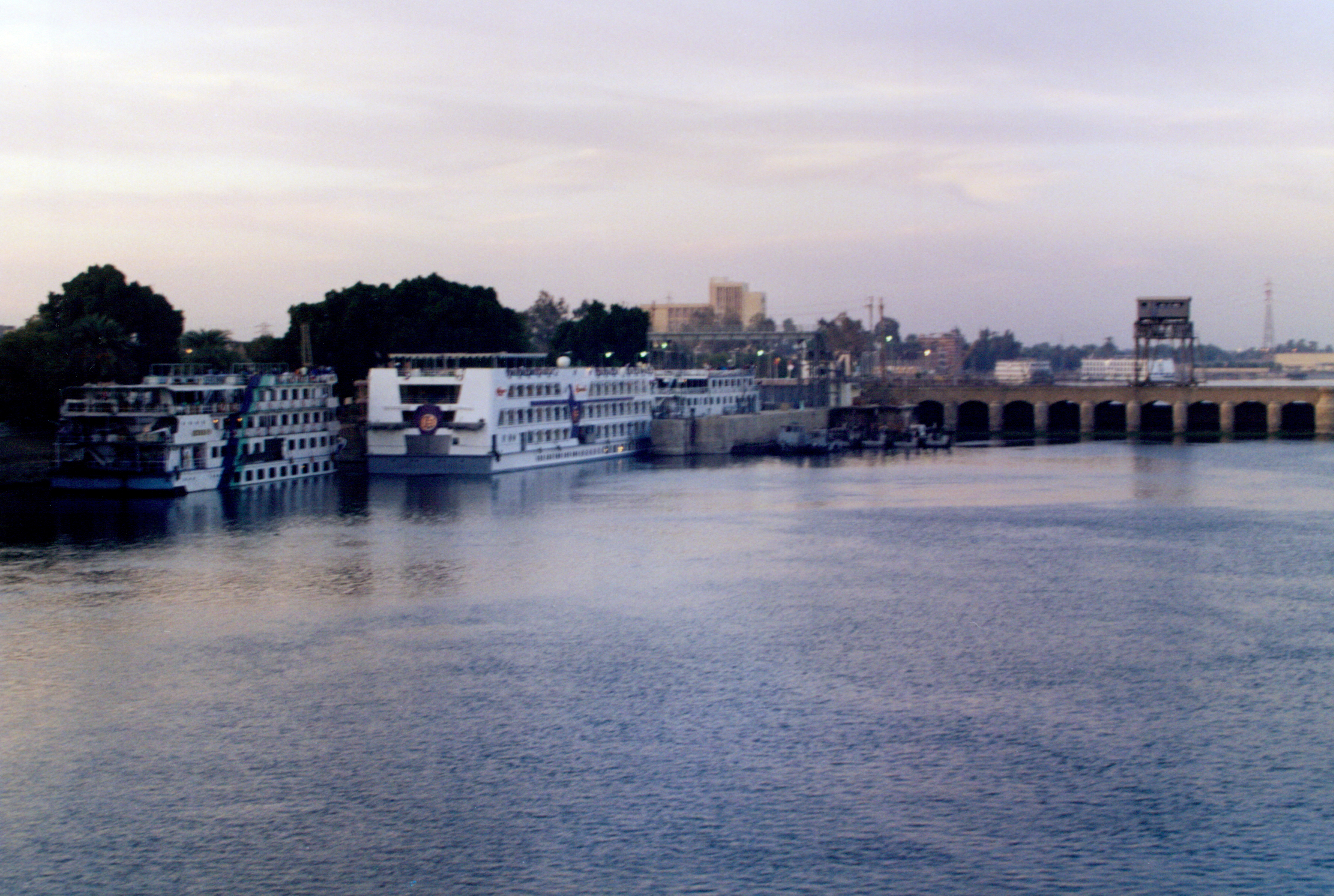
The Locks at Esna 
Hot in the day, cool at night
And that was the end of our trip. We came back to the boat, spent the last evening visiting the Luxor Souk and meeting friends for drinks at the Winter Palace Hotel, dinner on board and an early bed in time for our early departure on Monday the 4th. A six hour delay while our jumbo jet flew 350 Italians to Milan and came back to fetch us [this nearly caused a war in the broken down old departure lounge at Luxor Airport!] afterwards meant a long and tiresome day. James Curran fetched us from the airport and took us to our car parked outside his house in Brentford. We dined him at a local eatery [ghastly word] and got home not far off midnight. The door wouldn’t open properly there was so much mail and, as I have explained, we have been dealing with it ever since…………It was a grand holiday. Usually I’m ready to return home and pick up the cudgels again but this time I didn’t want to. The combination of a wonderful experience and the reality of life here with its looming unemployment and endless hustle for work has made it difficult to “get the balloon down”!
But still…here we all are. It was wonderful and we’ll go back again someday I hope.
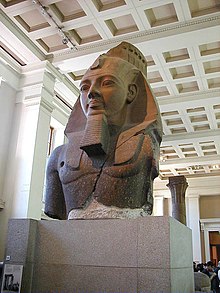
Ozymandias, Ramases II
When I was at Michaelhouse, Brian Law, in one of our English classes, made us learn Shelley’s Sonnet, Ozymandias. He saw the Ramesseum, the mortuary temple of that greatest of all megalomaniacs, Ramses II, on the west bank at Luxor and he wrote:
I met a traveller from an antique land
Who said: “Two vast and trunkless legs of stone
Stand in the desert. Near them, on the sand,
Half sunk, a shattered visage lies, whose frown,
And wrinkled lip, and sneer of cold command,
Tell that its sculptor well those passions read
Which yet survive, stamped on these lifeless things,
The hand that mocked them and the heart that fed:
And on the pedestal these words appear:
“My name is Ozymandias, king of kings;
Look on my works, ye Mighty, and despair!”
Nothing beside remains. Round the decay
Of that colossal wreck, boundless and bare
The lone and level sands stretch far away.”
— Percy Shelley’s “Ozymandias”

Muchest love to you all
Peterkin x
